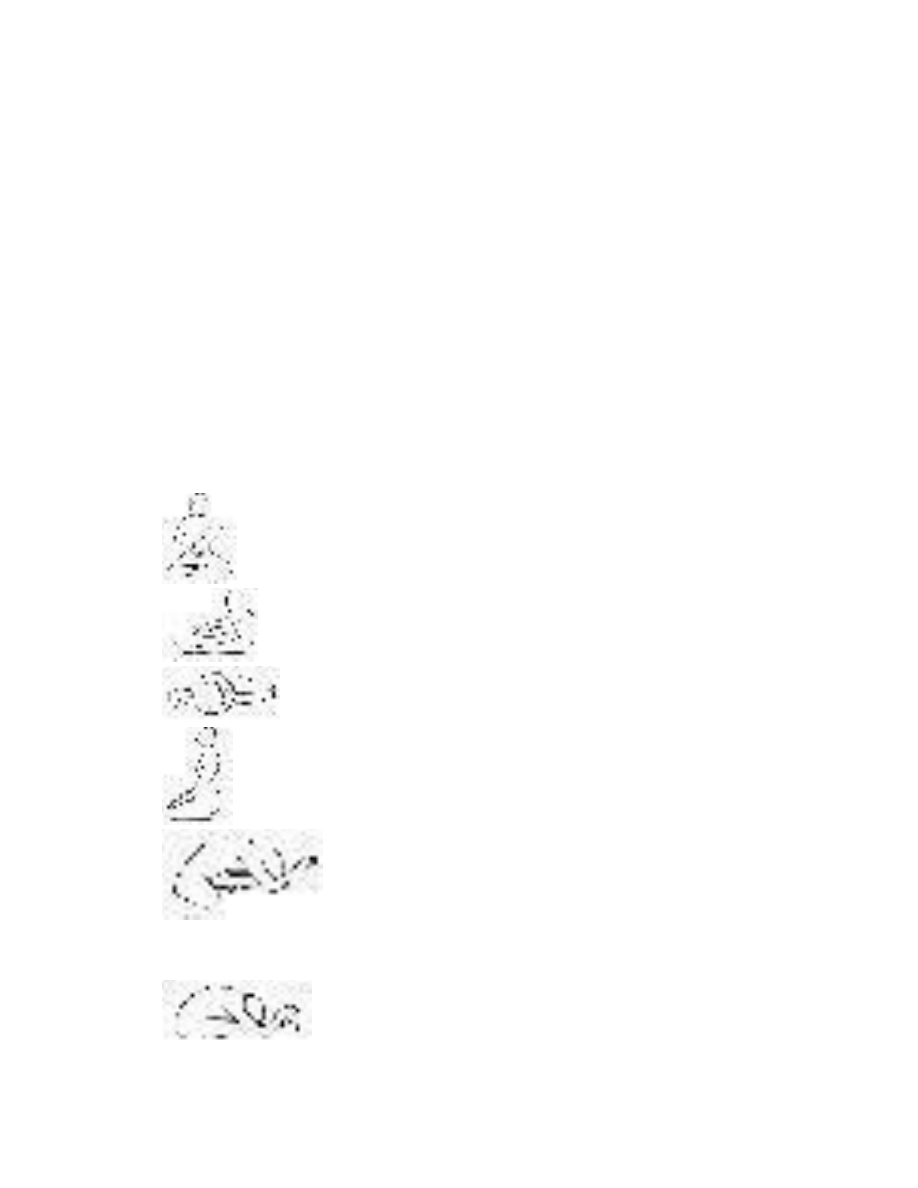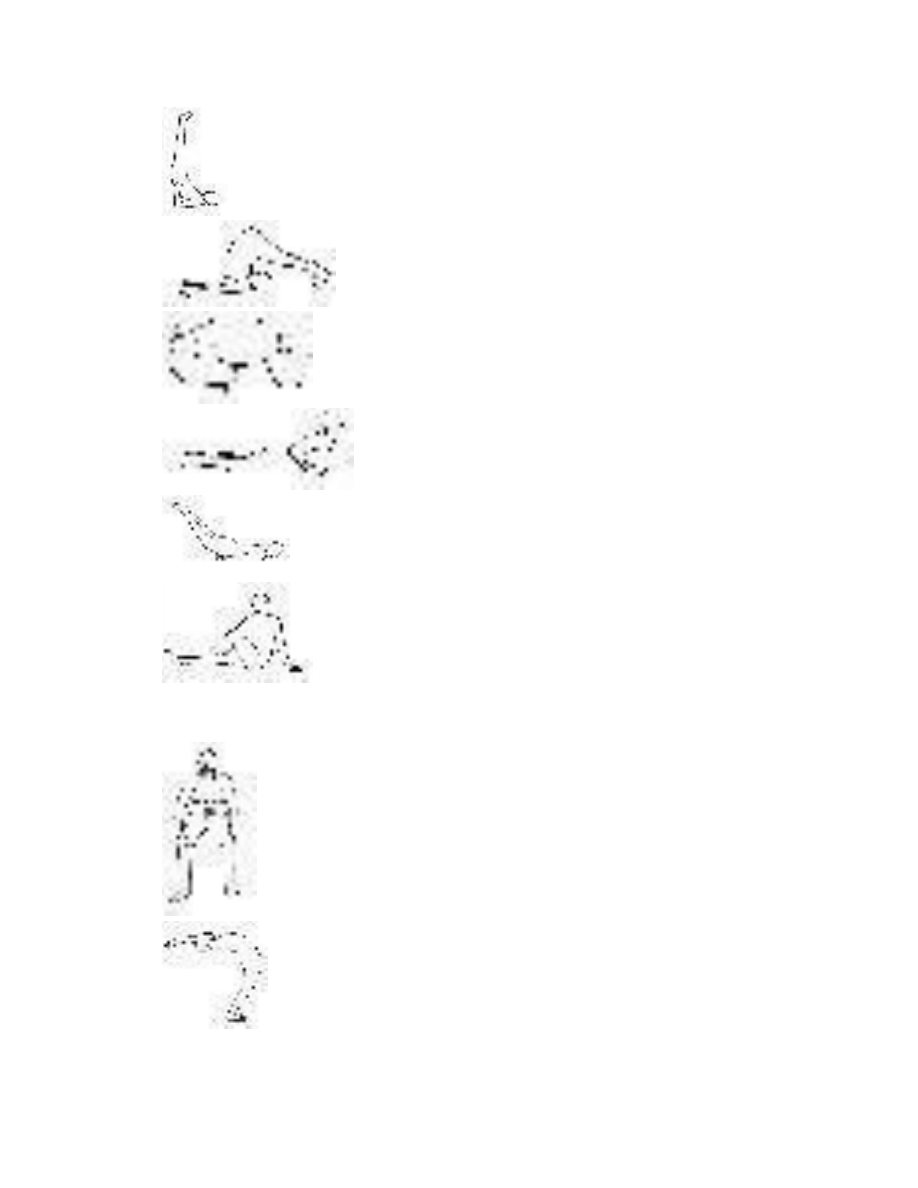
Samyama – Cultivating Stillness in Action, Siddhis and Miracles
Yogani
From The AYP Enlightenment Series
ISBN 0-9786496-2-1 (Paperback)

Life is a Miracle!
Introduction
Samyama is a powerful yoga practice that has been shrouded in
mystery for centuries. Yet, it is as close to us as our immediate hopes
and dreams, for it is the principles of samyama that are behind the
manifestation of everything in our life.
Inner silence cultivated in deep meditation is the primary
prerequisite for the conscious performance of samyama. With the right
foundation in place, remarkable things can be achieved, including the
rise of a constant flow of miracles in and around us.
The essential principles and practices of samyama are covered
here, simplified in a way that enables anyone to engage in daily practice
leading to results. A primary sitting samyama practice routine is
provided, along with an assortment of tools that enable the practitioner
to expand the applications of samyama as desired. Everyone wants
something, and the use of samyama offers the possibility for us to fulfill
our deepest desires.
But there is a catch. In order to fulfill our desires, we must
systematically surrender them to our inner silence, to the divine within
us. In doing so, all love and goodness will flow out with tremendous
power. This is the way of effective samyama – whatever we surrender
will come back to us a thousand-fold, and purified in a divine
outpouring. This is stillness in action…
So, while samyama is about getting what we want, it is also about
purifying and opening our nervous system to the divine within us. In
doing so, our desires themselves become purified and gradually ascend
to promote our highest purpose in life.
The Advanced Yoga Practices Enlightenment Series is an endeavor
to present the most effective methods of spiritual practice in a series of
easy-to-read books that anyone can use to gain practical results
immediately and over the long term. For centuries, many of these
powerful practices have been shrouded in secrecy, mainly in an effort to

preserve them. Now we find ourselves in the information age, and able
to preserve knowledge for present and future generations like never
before. The question remains: “How far can we go in effectively
transmitting spiritual methods in writing?”
Since its beginnings in 2003, the writings of Advanced Yoga
Practices have been an experiment to see just how much can be
conveyed, with much more detail included on practices than in the
spiritual writings of the past. Can books provide us the specific means
necessary to tread the path to enlightenment, or do we have to surrender
at the feet of a guru to find our salvation? Well, clearly we must
surrender to something, even if it is to our own innate potential to live a
freer and happier life. If we are able to do that, and maintain regular
practice, then books like this one can come alive and instruct us in the
ways of human spiritual transformation. If the reader is ready and the
book is worthy, amazing things can happen.
While one person’s name is given as the author of this book, it is
actually a distillation of the efforts of thousands of practitioners over
thousands of years. This is one person’s attempt to simplify and make
practical the spiritual methods that many have demonstrated throughout
history. All who have gone before have my deepest gratitude, as do the
many I am privileged to be in touch with in the present who continue to
practice with dedication and good results.
I hope you will find this book to be a useful resource as you travel
along your chosen path.
Practice wisely, and enjoy!
Table of Contents (Page numbers no longer correspond)
Chapter 1 – The Making of Miracles 12
How Our World is Manifested 13
Discovering Our Vast Inner Potential 15

Becoming a Channel of Infinite Expression 18
Chapter 2 – Samyama 22
The Yoga Sutras of Patanjali 23
The Technique of Samyama 25
Questions and Answers on Daily Practice 38
Symptoms of Purification and Opening 51
Self-Pacing 55
Rise of the Active Witness 60
Chapter 3 – Expanded Applications 63
Cosmic Samyama and Yoga Nidra 64
Samyama and Yoga Postures (Asanas) 73
Prayer and the Principles of Samyama 76
Samyama in Daily Living 86
Siddhis – Super-Normal Powers 91
The Importance of a Methodical Approach 94
Chapter 4 – Stillness in Action 98
Relationship of Inner Silence and Ecstasy 99
Flying on the Wings of Ecstatic Bliss 100

Let Go and Let God 102
Appendix 106
The Samyama Sutras of Patanjali 106
106
Further Reading and Support 117
Chapter 1 – The Making of Miracles
What determines achievement? Is it getting what we want, or is it
giving up what we want? Interestingly, it is both, and not necessarily in
that order. There is a natural process of gaining knowledge and its
associated achievements that has been observed in human beings since
the beginning of our history. To understand it is to know the secret of
making miracles.
We have all known people of achievement. No doubt we ourselves
have accomplished things in this life, and no doubt would like to achieve
more. There is the old adage that success is achieved by staying focused
on our chosen task. Persistent hard work toward our goal is the
prescribed formula we have heard since childhood.
Yet, why is it that great innovators like Sir Isaac Newton and
Albert Einstein tell us that they made their greatest discoveries while
doing absolutely nothing? Why is it that artists tell us that their most
beautiful creations flow through them, with the main work being to keep
up with that outflow?
Is there something systematic and effortless we can do that will
greatly enrich our endeavors in everyday life? We will explore it here,
and present an age-old method of yoga called samyama that takes
advantage of a principle in us that can give rise to remarkable
achievements, even entering the realm of the miraculous, all coming
from within as a natural flow of energy and creativity.

The samyama methods we will be discussing here are easy and
practical, and can help us make good use of the vast resources that are
available within us right now.
How Our World is Manifested
It says in the Bible that, “In the beginning was the word…”
And before that, what was there? Stillness, nothingness – an
infinite field of potential.
Then along came a vibration from the void – a word. An intention,
we could say. And from that, “…all things were made.”
In other words, the creation of the physical universe came out of a
vibration occurring in stillness, coming out of emptiness. Talk about
making something out of nothing. For lack of a better explanation,
astronomers call it “the big bang.”
With all of this going on, what has happened to that stillness, that
infinite field of potential? Absolutely nothing. It is still with us,
comfortably resting beneath the creation that came from it. It is the
eternal reality behind the mask of the material universe, and our world.
In the field of physics, this has been recognized quite clearly. We
now know that what seems to be solid is in every respect nothing but
empty space with miniscule points of energy whirling around each other
through the emptiness, giving the appearance and sensation of physical
matter. Physicality is a product of our perception. This appearance and
sensation of the physical is very real, as we all have found out when we
have banged into some of that empty physical matter. Yet, we know that
it is empty, all the same. Strange, isn't it?
So, even though we seem to have a rather frail and vulnerable
existence here on the physical plane, we know there is more to it than
that. There is a dynamic involved in all of this that comes from stillness,
from emptiness, from eternity. Not only that, we know that there is a
great intelligence involved. Can we look at a rose, a butterfly, or any
living thing, and say there is no intelligence coming out into expression
on this physical plane? To deny an innate intelligence is to deny the
obvious. Surely there is a vast intelligence expressing itself everywhere

we look. And it comes from within, constantly manifesting from
emptiness. Life is truly a miracle!
Einstein said that we can consider everything to be a miracle, or
nothing. It makes no sense to be picking and choosing our miracles from
this vast and wondrous universe. Either it all is a miracle or none of it is.
The Buddha said that if we could see the miracle in a single flower, our
view of everything would change. In layman’s terms, perhaps a miracle
is that which we have not yet taken for granted. Once we fully wake up
to the reality around us, nothing is taken for granted anymore.
And so it is with human beings too. We are part of the miracle of
life, that endless intelligence bubbling out from stillness into material
expression. Obviously, not everyone is in tune with this fundamental
truth. We do tend to get a bit distracted from our roots, and enmeshed in
materiality. The more enmeshed we become, the less innate intelligence
we have access to, and the less we are able to accomplish what we want
in this world. Life becomes a struggle when we can no longer operate
from our source, from our center.
If we wish to achieve our goals with maximum creative
expression, and with less effort, the obvious answer is to get in touch
with the source of all creativity and intelligence, the source that can be
found in the stillness within us. This is accomplished by untangling our
silent inner awareness from the habitual attachments we have developed
that have limited our expression on this earth. This untangling is a
process of inner purification and opening. There are highly effective,
time-tested ways for accomplishing this, ways that put us in alignment
with the vast forces within us that have created the entire universe. It is
through our own mind, emotions, body and nervous system that the
connection is achieved. Our possibilities for expression are as unlimited
as the infinite field of potential that underlies everything. We only need
to learn how to tap into it.
Discovering Our Vast Inner Potential
There are layers that constitute our physical and non-physical
existence. The methods of yoga are geared toward activating the

principles of evolution within us that unify our awareness and
functioning throughout these layers. Before we have undertaken the
practices of yoga, we may only be aware of the external layers of our
existence via the senses, intellect and emotions. It is a limited view, with
corresponding limits in our ability to fulfill our desires. It turns out that
we can use these same aspects of our nature to go much deeper.
Yoga means to join, or union. Hence, the methods of yoga are for
fully joining our inner and outer nature. In doing that, many new
revelations and capabilities will come to us. It is a homecoming, a
discovery of our full potential, which has been there within us all the
time.
But where should we start on our quest to tap our full potential? It
is a complex undertaking. Fortunately, the means can be greatly
simplified so anyone can immediately begin to open inwardly to great
peace, knowledge and power, and continue to expand on these innate
qualities throughout life. The possibilities are very exciting.
The essential constituent in all of this is the cultivation of inner
silence, which is accomplished first through daily deep meditation
practice. This is where it begins. It is not so much to do – sitting for a
few minutes morning and evening with an easy and powerful mental
procedure. Once we have some inner silence coming up and stabilizing
in our nervous system, many other possibilities open to us, including the
practice of samyama.
Inner silence has many other names – stillness, the witness, yoga
nidra, samadhi, pure bliss consciousness, sat-chit-ananda, tao, void,
emptiness, infinite intelligence, transcendence, and so on. They all mean
the same, with varying points of emphasis – describing that inner silence
which all human beings are capable of cultivating and sustaining
naturally. In the Bible it is written, “Be still, and know that I am God.”
Similar injunctions can be found in many of the ancient scriptures of the
world.
Humanity has been aware of its potential for a long time, if not the
means to cultivate it reliably. Now that is changing in these times of
rising knowledge and more effective applications of the principles of
human spiritual transformation that reside within all of us.

So we begin with deep meditation, which is covered in detail in the
AYP writings. Twice each day for 20 minutes or so, every day, like
clockwork, and our inner silence begins to stir in us. But wait a minute.
How can silence stir? How can stillness move?
This is one of the great mysteries of spiritual growth – the
awakening of infinite immovable silence within us. And it is moving! It
is a miracle of the human nervous system, an incredible vehicle of life
that can contain and dynamically express that which is both infinite and
immovable. But is it such a miracle? Look around you right now.
Everything you see is an expression of that same infinite and immovable
presence. We don’t have to go far to find a miracle. We are the miracle,
and it is all around us in everything we see in every moment. The more
integrated we become from the outside in and the inside out through
effective yoga practices, the more obvious it becomes.
Besides inner silence, there is another element of our inner
unfoldment that is good to understand before we charge ahead into the
methods of samyama. It is the rise of ecstatic conductivity within us,
which is the movement of ecstatic energy throughout our nervous
system. The Sanskrit word for energy is prana, which is stillness (pure
bliss consciousness) moving to manifest and animate all of material
existence, including our inner neurobiological functioning.
Ecstatic conductivity is an ever-increasing flow of energy/prana,
and is the means by which stillness moves within us, and far beyond. It
is also the means by which our sensory perception becomes highly
refined. Both inner silence and ecstatic conductivity are cultivated in
deep meditation. The rise of ecstatic conductivity is greatly enhanced
through additional specialized practices involving the breath, body and
sexuality. In the AYP writings many techniques are provided in addition
to deep meditation, with one of the most important being spinal
breathing pranayama.
With a balanced twice-daily practice of deep meditation and spinal
breathing pranayama, we are cultivating both inner silence and ecstatic
conductivity. Together, these provide the fertile ground for the
movement of inner silence through us, and outward. This is both the
discovery of our inner potential, and the cultivation of it for our benefit

and the benefit of others. To put it in more glamorous terms, we can also
call it the rise of abiding pure bliss consciousness, ecstatic bliss, and
outpouring divine love.
Whatever we choose to call the process, it is quite attainable by
anyone. As we engage in our practices, every step of development along
the way is a new beginning of possibilities for greater joy and fulfillment
that we could not imagine before. It is the stuff of miracles, and it is here
with us right now, ready for the asking.
Becoming a Channel of Infinite Expression
Some may be reading here who are interested in developing
siddhis (yogic powers), becoming a healer, or miracle maker. Or maybe
there are some gifts present already and we would like to expand on
them. This is fine, but it is a fact that none of us will reach our full
potential as long as we are only projecting our awareness outward into
the thing we are seeking. Neither can we be as successful or fulfilled as
we would like by attempting to possess an external expression of power.
It just does not work that way.
Real spiritual power cannot be owned or applied for our personal
use. It is much better than that.
Real spiritual power is essentially what we are, and it flows
through us effortlessly as we attune ourselves to our own inner nature.
It might seem strange to say that what we already are we cannot
own for our personal use. The truth is that we own it as we become our
Self, our inner silence. Before then we are merely banging on the gate. It
is foolhardy to be demanding what is in the castle from outside before
we have taken up residence in the castle that has been ours all along. As
it says in the Bible, “Seek first the kingdom of heaven, and all will be
added to you.” It is important to understand this point. If we want the
treasure, we have to claim the castle that contains the treasure. In doing
that, our entire life and point of view will be expanded in glorious ways,
and the treasure will be lying around everywhere. We might not even
notice the treasure because living in the castle is so much better than
having the treasure. The treasure we thought would be so wonderful is a

mere bauble compared to life in the castle. One thing is for sure. We will
never get the castle or the treasure by chasing the treasure alone. On the
other hand, we will always get the treasure if we take up permanent
residence in the castle. Is this such a difficult choice to make?
So, if this is the case, why bother with the treasure at all? Many
make this argument, speaking of yogic powers and such like they are the
problem, a plague to be avoided at all costs. Well, it seems logical,
except for one thing. In order to advance toward enlightenment (move
into our castle), it is necessary to fully purify and open our nervous
system to our inner reality and capabilities.
The purification and opening of the nervous system is a rather
large project for most of us, and we need every tool at our disposal to
progress as quickly as possible with the work. As we will see in the next
chapter, the real genius of yoga is in the multiple angles (limbs) it has
available for this work, with samyama being the icing on the cake of
yoga, so to speak.
The practice of samyama is therefore not for the development of
powers, but for advancing the process of purification and opening within
us. Put another way, there is so much treasure lying around the doorway
leading into the castle that we literally have to wade through the treasure
to enter the castle. It is not such a tricky business if we come to
samyama with a good foundation of inner silence, which means a good
foundation in deep meditation. Without inner silence we will not even
find the doorway to the castle, or any treasure either – inner silence is
the doorway, the castle, the treasure, and everything else.
But this is a bit of an oversimplification, because with our daily
practices over months, years and decades, our inner purification and
opening goes on, and on, and on, reaching ever more celestial heights. It
simply does not end. Indeed, enlightenment is not as much a final
destination as it is a never-ending journey of increasing divine
expression. It is happening all around us in nature, yes? And we can
continue the process as our individual evolution expands to become the
evolution of our community, nation, world and the entire cosmos. As we
become established in our inner silence and then begin moving outward
through it ecstatically, we literally become a channel of infinite

expression in the world. This is not a personal mission we carve out for
ourselves. It is the natural expression of what we are as we continue to
engage in our practices and go out into daily activity in a very normal
way. There is nothing so exotic about it. It is only life being lived as it
can be lived, in joy, freedom and outpouring divine love.
Samyama is an essential ingredient in all of this, because it
stimulates the movement of pure bliss consciousness (our inner silence)
to flow outward into expression in the world.
This is why samyama is so often associated with siddhis and
miracles. But the siddhis and miracles are incidental to the much greater
process that is going on. If we want siddhis and miracles for ourselves,
we cannot have them, not without incurring a large cost to our evolution
(the dark side). But if we want to help others and take care of our inner
business (the cultivation of inner silence and ecstatic conductivity), we
will constantly be surrounded by spontaneous miracles, in addition to the
sea of miracles we are living in already.
The real blessing is not the miracles themselves, but the fact that
we human beings have the ability to fully express the infinite divine
intelligence that resides within us.
Now that we have covered a few of the basics, let’s move into the
practice of samyama. As we go along, we will expand on the
possibilities mentioned so far. What we will find is that we are dealing
with a universal principle that is found in many fields of human
endeavor. It is the business of learning how to manifest the very best we
have to offer from within ourselves. We have much more to give than
we ever imagined, and we can do it with relative ease.
By the time we are done here, we will have covered a formidable
array of samyama tools that can be used in practical ways to enhance our
life and the lives of our loved ones, friends and everyone else both near
and far.

Chapter 2 – Samyama
While yoga is a fascinating subject to read about, ponder and
discuss, the real benefits come from practice. By this we do not mean an
occasional dipping in of the toe, though that is better than nothing. What
we mean is daily practice over months and years. If we do that with
some dedication, we can experience huge improvements in the quality of
our life.
It isn’t so difficult. We are not talking about going off to live in a
cave or anything like that. As a matter of fact, with an efficient approach
to yoga practices, like we discuss in the AYP writings, it can all be done
in a half-hour, more or less, twice each day. So we can continue with our
regular daily life as we did before. As a matter of fact, it is preferred that
we continue with life as before, because this helps stabilize what we gain
in our daily practices, and this speeds our progress along the road toward
enlightenment.
We will find that samyama is an optimized approach to doing what
we have been doing for all our life already – moving toward what we
want. With a difference. We will learn to systematically let go of what
we want, and in doing so, we will receive it a thousand-fold. The
principle of samyama is the same one found in the sometimes popular
and always perennial methods for utilizing our innate ability to attract
what we want into our life (law of attraction, law of abundance, etc.). In
doing so, we are releasing the things that have been holding us back.
Samyama is a systematic and highly efficient way of doing this. It can
work for everyone, because everyone is endowed with a human nervous
system. It is the human nervous system that is the doorway to the
infinite, and to all that flows from that divine realm within us.
Let’s take a quick look at where the knowledge of samyama comes
from, so we will have an understanding of its context within the overall
scheme of yoga. No part of yoga stands alone. Each practice we find in
yoga is a part of the whole, and the whole of yoga is much greater than
the sum of its parts.

The Yoga Sutras of Patanjali
Samyama is a word that we find in an ancient Indian scripture
called theYoga Sutras of Patanjali. It is one of the greatest scriptures of
all time, because it codifies in a few pages the essential principles and
practices for cultivating the natural process of human spiritual
transformation. All scriptures contain elements of the famous eight
limbs of yoga described in the Yoga Sutras. But very few scriptures
contain all of the limbs. So, besides being an excellent guide on the
essentials of spiritual practice, the Yoga Sutras make a pretty good
checklist by which the efficacy of any spiritual path can be measured.
The eight limbs of yoga are simple to list:
Yama: Restraints – non-violence, truthfulness, non-stealing,
preservation and cultivation of sexual energy, and non-covetousness.
Niyama: Observances – purity/cleanliness, contentment,
focus/intensity, spiritual/self study, and surrender to our highest ideal.
Asana: Those yoga postures we all know and love.
Pranayama: Breathing techniques for awakening and cultivating
the inner ecstatic energies.
Pratyahara: Introversion of sensory perception – awakening to
inner space and beyond, ultimately transcending sensory attachments
altogether.
Dharana: Putting attention on an object.
Dhyana: Meditation – natural dissolving of the object in the mind.
Samadhi: Absorption of the object and attention in stillness, inner
silence, pure bliss consciousness

Samyama is a specific means for combining the last three of the
eight limbs of yoga to produce a natural flow of inner silence outward,
or what we call stillness in action.
While the limbs of yoga are fairly easy to list and ponder, practice
is another matter. The most difficult part of yoga practice is keeping it
simple!
There is a common tendency among yoga practitioners to take a
rigid and difficult approach to the eight limbs of yoga. This can happen
easily if one starts at the beginning with the restraints and observances,
focusing on perfecting those before being permitted to move on to the
more powerful practices further down the list. In this case, we can end
up with a life lived by rules of conduct, with the natural joy and
spontaneity of the inner divine life being somewhat hard to come by.
This is not the approach in the AYP writings. Instead, we go
through the list somewhat backwards, and find the beginning of the list
so much more natural and easy that way, manifesting on its own from
inner silence, with rigid enforcement of the rules of conduct rarely being
necessary. We find the divine qualities of harmonious conduct coming
from within us automatically.
We do this by beginning with deep meditation, and then a form of
pranayama we call spinal breathing. Besides making for an easy and
enjoyable approach to the eight limbs of yoga, beginning in this way
fulfills a very important prerequisite for samyama. As was mentioned in
the last chapter, if we do not have resident inner silence, samyama
practice will not be doing much. So this is the route that is suggested. It
is quick and effective, and brings much peace and joy right from the
start. Then we will find all of our practices coming along very well,
including samyama. Before we know it, we will be noticing the rise of
inner silence in our daily life (the witness), and divine energy pouring
out in everything we do.

The Technique of Samyama
Deep meditation is the process of easily bringing the attention
inward to stillness, inner silence, pure bliss consciousness, the witness
state, samadhi. All of these are describing the same thing. We have a
particular deep meditation procedure that we do for a set amount of time
twice-daily. The procedure of deep meditation is fully covered in Deep
Meditation – Pathway to Personal Freedom, and in the AYP Easy
Lessons book.
Deep meditation works like clockwork and, over time, as we
meditate each day and then go out and are active, our nervous system
becomes naturally accustomed to sustaining and radiating inner silence.
Our daily life then becomes calmer from the inside. We are less
overwhelmed by external events. This is the rise of the first stage of
enlightenment, which is inner silence present in our life, twenty-four
hours per day, seven days per week (24/7).
Once we have some abiding inner silence, even just a little, we
have the opportunity to begin to operate from that level of infinite
potential residing within us. All that exists is manifested from that, and
we, being that, are capable of manifesting from that infinite reservoir of
life within us. So, with our toe in infinite inner silence, we can begin to
move from there for the benefit of our purification and opening toward
enlightenment. It is simple to do.
In deep meditation we use the thought of a sound, a mantra, to
systematically allow the mind to go to stillness. In the case of using a
mantra we do not use meaning, language or intellectual content, even if
our mantra happens to have a meaning in a particular language. We just
easily pick up the mental sound of the mantra, and we are able to dive
deep into pure bliss consciousness. The nervous system also goes to
silence with the mind, and our metabolism slows way down.
With samyama, we go the other way, from the inside out, instead
of from the outside in. And we use meaning.
After our deep meditation time is up, we sit quietly for a minute or
two, and then we transition into samyama. We begin, continuing in our
customary sitting position with eyes closed, in an easy state of not

minding any mental activity, just resting in our silence. If thoughts are
coming, we just let them go without entertaining them. In samyama
practice we do not entertain our mantra either. We start by not favoring
anything but being easy in our silence, however much silence we have
from our just completed meditation session, and also naturally present in
us from our months or years of daily deep meditation. This is the starting
point for samyama – abiding inner silence, stillness.
The only prerequisite for doing samyama practice is having some
inner silence. For most people this is after a few months of daily deep
meditation. The rise of ecstatic conductivity, cultivated with spinal
breathing pranayama and other means, is a great help in samyama also,
but is not a primary prerequisite for samyama practice. Ecstatic
conductivity plays a key role in providing a medium for transmission of
the effects of samyama. This will be discussed a little later. For getting
started with samyama, abiding inner silence, cultivated in deep
meditation, is the key.
Maybe we have been doing another kind of meditation, or are just
naturally quiet inside. Will samyama work for us? Maybe. There is only
one way to find out. Try and see. Do keep in mind that our samyama
practice will be most successful if we have a reliable daily meditation
practice that will continue to cultivate abiding inner silence in us. The
two practices work together like that. Remember what we said about the
whole of yoga being more than the sum of the parts.
Samyama Technique Explained
With samyama, we are initiating meaning in inner silence. We do
it in a simple, easy, systematic way. First we create an impulse of
meaning in silence using a specific word or short phrase, and then we let
it go in silence.
Let’s begin with Love. It is a good place to start with samyama. In
samyama it is suggested you use your most intimate language, the
language that goes deepest in your heart, whatever it may be. So, unlike
with mantra, samyama words can be translated to another language.

In your easy silence, pick up, just once, the fuzziest feeling of the
word Love. Don’t deliberately make a clear pronunciation, or mental
images of this or that scene or situation that represent Love to you. Just
have a faint remembrance of the word Love, and then let it go into your
silence, the easy silence you are in as you pick up the faint word Love.
Don’t contemplate Love or analyze it during samyama. Contemplation is
an impediment to samyama. So don’t think about it at all.
We don’t make an effort to physically locate the word Love in the
body. If it is here or there in a physical location, we don’t mind. We
don’t locate it, or try to stop it from being in a location.
Just come to the word Love once in a faint, subtle way, and then let
it go into silence. It is a subtle feeling of the word Love we are coming
to, nothing more, and letting then it go. Like that.
Having thought Love once, be in silence for about 15 seconds. If
any thoughts come, let them go easily. Don’t try and push thoughts out,
or hang onto them. Be neutral about whatever happens after picking up
and letting go of the word.
We do not deliberately coordinate our samyama with breathing, or
any other internal or external phenomena.
It is not necessary to look at the clock to measure the 15 seconds.
With a little practice your inner clock will tell you with good enough
accuracy when 15 seconds are up. Just be easy in silence for about a
quarter of a minute. Then pick up the faint, fuzzy word Love again, and
let it go into your silence for about 15 seconds again.
That is two repetitions of samyama – twice picking up Love at its
subtlest level of thought, and twice letting it go into inner silence.
What is the effect of this? What will happen?
To the extent we are picking up the word on the faint and fuzzy
border of inner silence (the subtlest level of thought), and then letting go
easily into stillness, the effect will be very powerful. Inner silence is a
huge amplifier of subtle thought. As a matter of fact, inner silence is the
only amplifier of thought. It is the wellspring of thought. Usually our
thoughts come out of silence colored by all that is lodged in our
subconscious mind. So many habitual patterns are lodged in our
obstructed subconscious mind, and these are what distort and weaken the

flow of divine energy coming out from inner silence into our everyday
life. With meditation we are clearing out the obstructions in the
subconscious mind and developing a clear presence of our inner silence.
With samyama we are acting directly within our inner silence to produce
a powerful outflow of positive effects that purify our nervous system and
surroundings.
During samyama we may feel some energy moving out from our
silence. It can be experienced as physical, mental or emotional. Or
maybe we won’t feel much until later on in our daily activity, and then
we may be more loving and compassionate for no obvious external
reason. We are changing from the inside. This is what samyama is –
moving our own intentions from the divine level of silence in us outward
into external manifestation. In doing so, our thoughts become purified to
a higher purpose, and are greatly strengthened.
No matter what thought we use in samyama, the effect will be
purification and opening with great power. Real samyama always
produces a positive outcome, no matter what we release into our inner
silence. This is a vital point that is little understood. Understanding this
and verifying it in our own experience dispels the fear, superstition and
dire warnings that often surround the subject of samyama. Such
warnings and fears are unfounded. Samyama is about purifying and
opening all that is within us, including any thought we can conceive of,
no matter how negative. Inner silence will transform the most negative
thoughts (obstructions) into a river of divine love. We will make
practical use of this principle in the next chapter.
The only negative effects we may experience in samyama may
come from overdoing in practice, which can lead to excess energy flows
associated with purification and opening. In other words, too much of a
good thing. We will cover effective measures for dealing with such
occurrences (see self-pacing). When choosing words to use in samyama,
our main objective is to have a balanced over all approach to purification
and opening, rather than focusing on this or that individual word or
phrase.
Samyama is what prayer is when taken to its deepest level of
communion within us, and released within divine inner silence. As we

will see in the next chapter, effective prayer is based on the principles of
samyama, and can involve just about any quality or obstacle we would
like to illuminate with pure bliss consciousness from within, assuming
we have met the prerequisite of having some abiding inner silence.
Sutras for Balanced Purification and Opening
Each word or phrase we use in samyama is called a sutra. In
Sanskrit, sutra means, tied together, or stitched. The English medical
word, suture comes from sutra. When used in samyama, sutras are code
words orphrases that represent particular meanings. We use sutras to
telegraph particular meanings into unbounded pure bliss consciousness.
There they are purified and amplified out through us into everyday life.
This process joins our inner and outer life. So, sutras are aspects of yoga
(union) we can consciously cultivate in ourselves through samyama
practice. Taken together, a well-selected list of sutras can provide
broad-based purification in our nervous system, and far beyond.
As with all yoga practices, the benefits from samyama are to be
found in long term daily practice. If we use a balanced routine of sutras
and practice regularly, great benefits will accumulate gradually in our
life. If we keep changing sutras around every day or week, and are
irregular in our practice, the results will be diluted accordingly.
If we want to strike water, we will do best to keep digging in the
same place. We can do samyama after every meditation session, and
then take 5-10 minutes of rest at the end. Samyama is a continuation of
our sitting practice, which includes spinal breathing pranayama followed
by deep meditation. With pranayama and meditation, we are going in,
and then we are coming out with samyama. So, once we have completed
our deep meditation, we relax in silence for a minute or two on our seat,
and then begin samyama.
For our samyama practice, a balanced series of nine sutras are
given here, covering a full range of qualities, which will provide for
balanced purification and opening in our nervous system. The
suggestion is for each sutra to be done for two cycles of samyama,
picking up each faintly two times with about 15 seconds in silence for

each repetition, and going through the list in order like that. In a few
days they will be memorized and easy to navigate through using this
method of samyama, going gradually deeper in practice with each
session.
The sutras are:
• Love
• Radiance
• Unity
• Health
• Strength
• Abundance
• Wisdom
• Inner Sensuality
• Akasha – Lightness of Air
Each sutra is to be picked up faintly in its entirety, and released
with about 15 seconds in silence afterward, using the same technique we
described for Love.
For example, Inner Sensuality is a single sutra followed by 15
seconds of silence. This sutra is for pratyahara (introversion of the
senses). Akasha – Lightness of Air is also a single sutra, followed by
fifteen seconds in silence. It is to promote lightness of body, and the
corresponding lightness of heart and mind.
As mentioned earlier, the sutras can be translated to our most
familiar language. In the case of Akasha, this is a Sanskrit word
meaninginner space. The words Inner Space – Lightness of Air can be

translated to create the sutra in another language, if desired. We know
from physics that we are empty space inside, nothing really solid in here
at all. Our body is that, and when we do samyama on Akasha –
Lightness of Air, or its equivalent, Inner Space – Lightness of Air we
begin to feel very spacious and light. When we know the body is empty
space, it can be easily transported anywhere.
If you do each of these nine sutras twice in your samyama session,
letting go each time for 15 seconds, it will take about five minutes. If
there is a particular sutra you feel the need to do more of, then add that
one to the end and do samyama with it exclusively for another five
minutes. The cycles remain at 15 seconds with the last sutra, and we just
keep going with that for the additional five minutes. There is no need to
count repetitions during the last five minutes of practice. We can just
peek at the clock when about five minutes have passed. When time is up,
then stop and rest for 5-10 minutes. If there is room to lie down during
rest, this is good. Otherwise, just lean back comfortably during the rest
period.
If there is no preference, then you can use the lightness sutra for
five minutes at the end. It is very powerful. It is a mental technique that
brings much energy up through the nervous system. It is not uncommon
to experience physical symptoms such as panting (a form of automatic
pranayama), shaking and hopping during samyama with the lightness
sutra. If this happens, make sure you are sitting on a soft surface like a
mattress. There can be a variety of symptoms manifesting with the other
sutras as well.
We are moving infinite inner silence from within us, so the
manifestations coming out can be very real and noticeable. Patanjali
calls these manifestations super-normal powers, or siddhis. Our energy
surges and physical symptoms represent the early stages of siddhis.
Later on, as inner purification and opening advance, the physical
symptoms we may have experienced will become much less, and we
will notice spontaneous events in our life signifying inner support rising
all around us. This is the natural rise of siddhis and miracles in our
everyday life as we are purified and opened from within.
The symptoms we may experience beforehand are the result of

energy encountering inner obstructions in our nervous system. The
sensations and movements are caused by friction as our inner energies
are gradually dissolving the obstructions. As the nervous system
becomes purified, the friction becomes less, even as the energy flow
increases to bring increasingly wonderful manifestations of divine grace
into our daily life.
Whatever the symptoms may be, we just easily favor the simple
procedure of our samyama. We do not favor thought streams, energy
movements, physical movements, breathing patterns, or any other
symptoms that may come up during samyama. We don’t try and force
our experience one way or the other. We just favor the easy procedure of
samyama, and the rest comes naturally.
Moral Self-Regulation
In the third chapter of the Yoga Sutras of Patanjali on
Super-Normal Powers, a variety of sutras are given. They are reviewed
in the Appendix of this book from a practical point of view. The sutras
are offered in simplified form, so research on them may be undertaken,
if desired, once we have become well established in our daily routine of
samyama practice as presented in this chapter and the next one.
Research using an open list of sutras, as may be derived from those
offered by Patanjali, is not recommended before then. This is further
discussed in the Appendix.
All that we are presenting on samyama and sutras is not for
obtaining instant results or powers. If it were, we would not be doing
any favors in terms of helping anyone advance along the road to
enlightenment. As pointed out by Patanjali, powers for their own sake
would be great distraction to yoga, if they were so easily obtained on the
level of limited ego consciousness.
Fortunately, samyama is a morally self-regulating practice, which
means inner silence (samadhi) is the prerequisite for success in
samyama. Inner silence is beyond ego consciousness. If there is inner
silence, there will also be rising moral responsibility and conduct (yama
and niyama), due to the natural connectedness of all the limbs of yoga.

Along with this comes dispassion for the external performances of
siddhis. Interestingly, the more advanced we become in our samyama
practice, the less attachment we will have to the results. The flip side of
this is that the more interested we are in siddhis, the less effective our
samyama will be, because we will have less inner silence. This is
self-regulation coming from within.
So, the dire warnings we so often hear about powers derived from
samyama are overstated. Whatever sort of attachments we are warned
about cannot come from effective samyama practice, because effective
samyama practice is without attachments (beyond ego), by definition.
Samyama is having inner silence (samadhi), the ability to pick up a
thought (focus/dharana), and let it go inward (meditation/dhyana), all at
the same time. Then the results of samyama come out from inner silence
automatically. If we have the last three limbs of yoga (samyama), we
will also have all the other limbs of yoga manifesting (they are all
connected within us), so any powers arising from samyama will be
divine in purpose.
Even so, we should be clear about our experiences versus our
practices, and be mindful not to get too caught up in experiences that
come up. Whenever experiences do come up, we easily come back to the
practice we are doing. This is important, because experiences do not
produce spiritual progress. Practices do. So, while there is not any great
risk of calamity within samyama practice, the experiences we will
encounter sooner or later can distract us, and water down our practice.
This can happen if we go off the procedure of our practice and engage
ourselves in the scenery, as it were. This is why we easily favor our
practices over our experiences in all aspects of our yoga routine, not
only in samyama. When we are out of practices in our daily activity, we
can indulge in our inner experiences and enjoy them if we wish. There
will be plenty to enjoy!
Let’s make sure to take plenty of rest when coming out of our
routine of practices, especially when doing samyama. Lying down for
5-10 minutes at the end is ideal – longer is okay too. Mental techniques
such as deep meditation and samyama are very powerful. They produce
a lot of purification and opening within us, so it is important to rest at

the end of our sitting routine to allow everything to settle down inside. It
is equally important to go out into activity after our practices and rest.
Full engagement in activity in our daily life will stabilize what we have
gained in our practices, and produce permanent positive effects.
It is important not to overdo in our practices, as this can result in
uncomfortable energy flows during and after practices. Later in this
chapter, we will discuss application of the principles of self-pacing,
which will enable us to maintain maximum progress with comfort and
safety.
Samyama greatly strengthens our presence in the silence of pure
bliss consciousness. It promotes an integration of the inner and outer
aspects of our neurobiological functioning. It stimulates the nervous
system to purify and open, leading to a continuous flow of silent bliss
outward from within us.
We call it stillness in action, making the overall power of our
desires much stronger. When we want to accomplish something that is in
tune with the divine flow, resistance will be much less and obstacles will
seem to melt away. If our initial desires are misguided, they will be
redirected from within in ways that invariably lead to a positive
outcome. For those who live in the silence of pure bliss consciousness
and develop the habit of functioning naturally from that infinite level of
life, a constant stream of small miracles becomes commonplace.
None of this has to be taken on faith. Try samyama practice for a
few months after your twice-daily deep meditation practice, and see for
yourself. Samyama is much more than a sitting practice. It is a means for
culturing thinking and doing in our everyday life in a way that brings out
the higher purpose that resides within us. As this occurs, we are
naturally propelled along our path toward enlightenment.
Questions and Answers on Daily Practice
As soon as we begin our daily practice of samyama, questions are
bound to come up. They can be on subjects ranging from the basics of
the technique to new experiences that can occur. We will cover some of
the key questions on practice here, and delve into the dynamics of

experiences in the following sections.
Nothing much seems to be happening during samyama. Am I ready
for this?
You are ready if you sense some abiding inner silence, feel in your
heart you are ready, and if you can sustain a daily practice. As with deep
meditation, we do not measure the results of samyama by what is
happening during the practice itself. The real measure will be in how we
feel during our daily activities, in-between our sittings. If we feel more
peace, creativity and happiness in life, that will be a good indication of
results occurring, even if our samyama sittings are uneventful. This is
true of all yoga practices.
The fruit of yoga is found not in what happens during the practices
themselves, but in how they affect the quality of our life.
What is the difference between picking up and releasing the word,
Love, and contemplating Love during samyama?
The sutras we use in samyama are code words for information that
is already embedded deep within us with language. Picking up the sutra
alone and releasing it into our inner silence will merge the full content of
meaning automatically with our resident pure bliss consciousness, just as
speaking a word out loud will automatically convey its meaning
externally to anyone who understands our language. If we understand
our language, so does our inner silence, so we need not worry about
conveying meaning with our sutras.
We do not contemplate during samyama, as this will keep us
engaged in thinking and prevent the absorption of the sutra in inner
silence. Less is more when we are going inward. We just follow the easy
procedure for picking up the sutra at that very faint and fuzzy level every
15 seconds, and let it go. Very simple.
If we wish to contemplate the meaning of our sutras outside
samyama practice, this is fine. It is good for us to understand the
meaning and intent of our sutras. It is we who determine that. It does not

come from somewhere else. It will become part of our inner
programming, as is the case with all language. This is why we do the
sutras in our own language, so the meaning of the words will be alive in
seed form deep within us. It is not necessary to overdo it and think about
the meaning of our sutras all day. We just easily come to know what
they are and what they mean. That’s all. When we sit to do samyama, we
forget all that and just use the sutras as suggested, and the best results
will be there.
There is a story in the Bible about how difficult it is for a rich man
to enter the kingdom of heaven, as difficult as a camel going through the
eye of a needle. It is like that with samyama too. If we are “rich” with
thinking and meanings, contemplation, etc. during our samyama, then
letting go into inner silence will be like trying to put a camel through the
eye of a needle – nearly impossible. But if we pick up the sutra in that
very faint and fuzzy way in the mind and let it go, then it will go into
inner silence easily. The camel will become very small and indistinct,
almost nothing at all, and go right through the eye of the needle. Then
the results will be very good. That is how samyama works.
I am having trouble keeping with the 15-second interval. Any
suggestions? And why 15 seconds?
In samyama, timing is simply a matter of developing a habit. It
takes several sittings to do that. The nervous system actually has a very
accurate clock built into it, and we can access it simply by engaging it
repeatedly in our practice. In deep meditation this is true, and it is true in
samyama also. However, there is a difference.
In deep meditation, most of us will follow the easy procedure for
20 minutes. Peeking at the clock near the end of the session is a suitable
way of confirming where we are in time.
In samyama, we don’t want to be peeking at the clock to verify
every 15-second interval. That would be too much distraction from the
natural process we are engaged in. Instead, what we do is go through all
of our sutras for the two repetitions each and check our time near the
end, or when we are done. Then we will know if we have been going too

fast or too slow, and we can make an adjustment the next time we sit to
practice.
We know that nine sutras done twice each with a 15-second
interval will be about five minutes of samyama practice. If our session is
coming in around five minutes, we will be on track. If it is significantly
shorter or longer, we can make an adjustment. Over a few days or weeks
the approximate 15-second interval can be achieved in that way.
For extended use of our last sutra for five minutes (Akasha –
Lightness of Air, for most of us), we can go back to the same method of
timing we use for deep meditation, rather than counting repetitions. So
we just go on with the sutra with the approximate 15-second intervals
until five minutes have passed. Having established the 15-second
interval with our other sutras, we can be reasonably confident that we
will remain on track with our last sutra for the five minutes at the end of
the session.
From our own experience, we will find that 15 seconds is about the
right amount of time for a sutra to be released in inner silence, and
enlivened from within to produce its given effect via the process of
moving stillness. Then another repetition of the same or next sutra will
be necessary to continue the process of cultivating moving stillness. The
human mind and nervous system are pre-wired for this approximate
duration of processing in samyama, much as they are pre-wired for
about 20 minutes of deep meditation per session for most people.
If we go significantly shorter than 15 seconds between sutra
repetitions, there will not be enough time for stillness to fully absorb and
move from within the sutra. This is a common occurrence in samyama
practice – going through the sutras without adequate time of letting go
in-between repetitions. This happens when the mind is fully engaged,
which we are all prone to have happening in our busy lives. But this is
samyama, where letting go is essential. The thing to do is develop the
habit of letting go and allowing inner silence do its work, not minding
thoughts or other experiences that may come up. In time, we learn to
trust the process. It works!
Think of it this way – each repetition is a fraction of a second of
faintly picking up the sutra, and 15 seconds of letting go. So, what is

samyama primarily about? Is it primarily about the sutras? No, it is
about letting go!
The reason we do not deliberately go much beyond 15 seconds
between repetitions is because our awareness is naturally coming back
out into thoughts by then, and is looking for something to latch on to.
Either that, or the mind will be wandering aimlessly after about 15
seconds. It is the nature of the mind. So we give it another sutra
repetition at that point, and let go. Because samyama is an enjoyable
process, the mind will be happy to go with the sutra into stillness again.
Sometimes we will lose track of the time and go way over 15
seconds. It can happen. That is covered next.
Is getting lost during samyama practice okay? And once I realize it
has happened, what do I do?
Losing track of our sutras is common, even for advanced
practitioners, due to ongoing purification and opening occurring in the
nervous system. It can happen to anyone at any time, and there is
nothing to worry about. When we realize we have wandered off from
our sutra practice, we just easily come back to it, wherever we left off.
If we find ourselves in a blizzard of thoughts, we do not hang on to
them or try to force them out. We just easily come back to our samyama
practice whenever we realize we have wandered off into a stream of
thoughts, or any other experience.
Of course, wandering off and coming back to our sutras after some
time has passed can mean our overall time will be longer. That is fine if
we have the time. If we run out of time, then we can end our session as
necessary wherever we happen to be in the sutra sequence and lay down
to rest. There will always be other sessions, so we do not have to fret
about an interrupted sequence of sutras. It has been for a good cause –
our purification and opening, and for the ongoing process of our
enlightenment. Everyone goes through changing experiences in
samyama. Over the long term, samyama practice tends to become more
steady and stable, as inner purification and opening advance in our
nervous system.

If we get lost during the five-minute session with our last sutra, we
can just lie down and rest if our time is up, when we realize we have
been off somewhere.
It is common for such variations to occur, and we don’t have to be
concerned. It is our long term practice that will make the difference, so
any variations that occur we just take in stride and keep on with our
twice-daily practice.
I have heard that concentration is one of the key elements in
samyama, but you do not mention it. Why?
In the style of samyama we are doing here, we pick up the object,
the sutra, with attention and let it go. That picking up is called dharana,
the sixth limb of yoga. The letting go is dhyana, which is the dissolving
of the sutra, the meditation component, the seventh limb of yoga.
Absorbing of the released sutra into our inner silence is the samadhi
element, the eighth limb.
It is important to recognize that when we are picking up the sutra
in a very faint and fuzzy way, then all three limbs of yoga will be
coexisting at the same time. This becomes very natural and easy as our
inner silence becomes steady and stable from our well established deep
meditation practice and increasing experience in samyama. So, samyama
is all three aspects together, and this is the essential cause that yields the
remarkable effects of samyama.
While it might seem ironic, the clunky stage we may experience
for a few days or weeks when getting started in samyama practice is
caused by too much fixation of the mind on the surface level of the sutra.
In other words, too much concentration. Success in samyama comes
from touching the sutra faintly with awareness and letting it go. It is that
simple.
The word dharana, is often translated to mean concentration, and
this is a reflection of how some traditions practice both meditation and
samyama, at least at certain stages, riveting the mind on an object (like a
mantra or sutra) until it wears out and falls into stillness. Hence the word
concentration. But this is not how deep meditation and samyama are

practiced in the AYP approach, so we do not use the word concentration
in relation to practice to avoid confusion with techniques taught
elsewhere. But we do talk about concentration in another way.
Concentration means intense or completeattention. As we advance
in our practices and experiences, inner silence continues to rise and
stabilize in us, with many benefits. One of those benefits is the ability to
increasingly focus attention like a laser beam on any task or object for an
extended period of time. In other words, over time, yoga vastly increases
our power of concentration. This ability to concentrate is an effect of
yoga practices, which, in turn, becomes a cause in all that we undertake
in life. An increased ability to concentrate is a practical benefit coming
from yoga – one of many.
Like so many things in spiritual life, the rise of concentration from
undifferentiated inner silence is a seeming paradox. Yet it happens. The
more awareness (inner silence) we have available within ourselves, the
more we are able to focus our attention intensely on external tasks for
long periods of time.
When we engage in the efficient process of samyama on a daily
basis, the flow of inner silence outward takes on a much more active role
in our life. In time, it becomes a vast outpouring of attention, positive
energy, intelligence and love that can lead to remarkable achievements.
It is the stuff of miracles!
I have been doing Buddhist meditation for years. Can I use this
style of samyama with it?
The fuel of samyama is inner silence. Any meditation technique
that cultivates inner silence will be a support for samyama practice. So,
Buddhist meditation will work to the extent that it cultivates inner
silence. Typically, the best time for structured samyama practice is right
after meditation, which is the time when the most inner silence is likely
to be present. We always rest for 5-10 minutes after samyama practice
(lying down is good) to facilitate the winding down of inner energy flow
and purification in the nervous system that may be occurring deep
inside. If we get up too quickly, there can be some irritability in daily

activity.
Samyama also works outside sitting practices, and we will get into
that in the next chapter. Suffice to say that our genius resides in stillness
within us, and to the extent we are able to entertain our desires in
stillness, the likelihood of their fulfillment will be greatly enhanced.
Einstein, Newton, Mozart and many others stand as testaments to this
fact. Where there is inner silence and the principle of samyama
operating, there is genius. It is in all of us.
Is doing samyama for gaining personal power wrong? Is it
dangerous?
Of all the ways we can seek to increase our power in the world,
samyama is the least dangerous. This is because true samyama is not
projection. It is not acquiring anything, or manipulating anything in the
world. Samyama is surrender to the divine within us. There is no harm
that can come from this, even if we are doing it for selfish reasons.
What is not done for selfish reasons anyway? Everything we do is
for our own self, even if we are making great sacrifices for others. It is
merely a matter of what we regard our self to be. When we become
filled with the joy of pure bliss consciousness, we begin to find our own
self in everything and everyone around us, and act accordingly. This is
the direct result of daily practice of deep meditation and samyama.
So, if we have some egotistical desire for enlightenment, or for
some powers to exercise in the world, this is fine. Learn deep
meditation. Learn samyama, and go for it. What will happen as we
continue with practices and act in the world is, we will expand from the
inside. As we do, our view will expand, as will our sense of self and the
quality of our actions. Then we will be projecting our personal desires
less on others, and surrendering them more into stillness. What comes
out from that will be divine flow, no matter what sort of impure thoughts
we have been letting go inside. It is a natural process of purification. It is
very simple. Samyama is divine judo that takes all desires and elevates
them to divine status, which then manifest as all love and support for
everyone around us. This kind of surrender is not weakness. It is the

greatest strength that can be found in life, nourished by the infinite
residing within us.
So the fear about samyama being abused and used for wrong
purposes is a myth. It is not possible with right practice. We can say that
samyama is morally self-regulating, meaning that the deeper we go into
it, the more moral strength we will have coming out from within us. If it
is not right practice, not letting go into stillness, it is not samyama, and
the power coming out will be much less.
Samyama is not projection of personal power. If there is projection
involved in a practice, it is something else. It can be misguided ego, the
dark arts, whatever we want to call it. It isn’t samyama. If there is a
danger, it is in the personal projection of power. Many of the world’s ills
have come from this. Samyama is the great undoer of egocentric
adventures that have caused so much misery in the world. Correct
practice of samyama is infallible in its results. And incorrect practice of
samyama will not work. It is very safe.
So, let’s begin samyama, and all that our heart craves deep within
will be given to us, and much more.
I am experiencing fast breathing and physical movements
sometimes during samyama. What is it?
When we systematically let go of our sutras in samyama practice,
inner silence will begin to move inside us in particular ways that reflect
the flavor of the sutras we are using, giving rise to a variety of
sensations, thoughts and feelings. These will be the result of purification
occurring in our nervous system. The movement of inner silence
outward can also be experienced as energy moving through us, which
can give rise to physical symptoms, such as alterations in breathing and
physical movements.
Sometimes we call physical symptomsautomatic yoga, since they
may resemble yogic maneuvers and breathing practices. By automatic
yoga, we do not mean practices we must follow when they happen. The
way we handle such symptoms is to neither favor them, nor try and push
them out. We just easily favor the practice we are doing over such

experiences. In this case, the easy procedure of our samyama practice.
It is possible for the symptoms to become dramatic, such as the
body beginning to shake and hop on our meditation seat during the
lightness sutra. If this happens, we should take necessary precautions to
protect ourselves and the furniture, by avoiding such activity on a fragile
bed and having suitable padding underneath ourselves on a solid surface
during our samyama. While our practice might seem chaotic sometimes,
there is a method to it, and a lot of intelligence manifesting from within
along with the energy. Still, it is up to us to take whatever precautions
we feel are necessary to assure our safety. This is true for all yoga
practices, and is an aspect of self-pacing.
Physical movements are caused by the friction of inner energies
moving through our not yet fully purified nervous system. The further
along the path we go, the more purification and opening we will have,
and the less likely extreme physical movements will be. Then the
experiences will be more along the lines of abiding inner silence,
ecstatic bliss and outpouring divine love.
Along the path of purification and opening, we can have all sorts
of things going on. It goes with the territory, and we deal with things as
they come up in ways that assure our ongoing progress with comfort and
safety.
I am filled with bright light and pleasurable energy during
samyama, and for some time after. Is this the right result?
This is another way our purification and opening can be
experienced. It means we are experiencing inner energy flow with less
friction involved, which can give rise to experiences of inner light and
ecstasy. Such experiences can come and go along the path of inner
purification and opening.
Having this kind of experience does not mean we have arrived.
More than likely we will continue to have many ups and downs along
the way. It is a preview of what our life will be like permanently in the
long term. The main thing is to continue with daily practices, and favor
that over any lovely experiences that might distract us from doing the

very practices that have created the experiences.
There are good things happening. It is our practice that is causing
these experiences, so always favor the practice.
Why do I feel edgy and irritable after my samyama practice
sometimes?
Irritability can result if we are overdoing in our practices, or
coming out too fast, not taking adequate rest at the end of our sittings.
One of the most common causes of irritability in activity is getting up
too soon after practices. So be sure to address that first. It is very
important to take at least 5-10 minutes of rest after our samyama
practice. If we have a place to lie down during this time, it is good.
If irritability persists after practices, even when we are taking good
rest before getting up, it can be overdoing in our practices. In the case of
samyama, if two repetitions of our sutras is leaving us with irritability,
then we can drop back to one repetition for a few sessions and see if that
will help. Or, if we have forged ahead and are doing more than two
repetitions of our sutras, and are having difficulties in our daily activity,
then we should scale back a bit until things stabilize.
Irritability can also be caused by overdoing in any of our practices,
so it is good to take a broad view of all the practices we are doing, and
consider making adjustments in the practices that are most likely causing
the excess energy flow and purification.
We will discuss the art of self-pacing in our practices more in the
next sections.
What is the ultimate purpose of doing samyama?
As mentioned, whatever our purpose may be, be it for self or
others, it will be a good enough reason to begin samyama, assuming we
have been cultivating a foundation of inner silence beforehand. From
there, the process of samyama itself will take us steadily toward our own
higher purpose. If we are looking for powers, samyama will deliver
them, but not necessarily in the way we may be expecting. When we

engage in samyama, we may not always get exactly what we want, but
we will always get what we need to advance on our spiritual path.
Ultimately, samyama, in conjunction with our other yoga practices,
will lead us to enlightenment, which is abiding inner silence, ecstatic
bliss and outpouring divine love.
Symptoms of Purification and Opening
All spiritual progress is based on the natural processes of
purification and opening within us that are stimulated by spiritual
practices. The more effective our practices are, the more purification and
opening will be occurring, and the more spiritual progress we will
experience in all avenues of our life.
Once we have our routine of samyama going, the symptoms of
progress can vary widely, depending on several factors:
• The degree of abiding inner silence we have.
• The effectiveness (simplicity) and regularity of our samyama practice.
• The unique matrix of obstructions we each have embedded in our
nervous system, which is gradually being unwound as we travel along
our spiritual path.
• The intensity of our desire to progress spiritually. We call this bhakti –
which means devotion to our highest chosen ideal.
Actually, bhakti comes first, because it is desire that fuels all of our
endeavors along our spiritual path. Without desire, not much will
happen. It is desire that determines what we will be practicing and when,
and, to a degree, the effectiveness of our practices. When our heart is
calling for the divine, the divine responds in kind. This is well known
throughout the world.
But we need not be dependent on bhakti alone. Only a little desire
(even skeptical curiosity) that inspires us to engage in practices like deep

meditation, spinal breathing pranayama and samyama will have
far-reaching consequences in our progress. Spiritual practices greatly
leverage our bhakti and bhakti greatly leverages our spiritual practices.
The whole is much greater than the sum of the parts.
In the case of samyama, the stimulation is initiated at the most
subtle level of our being, within pure bliss consciousness, our inner
silence. In order for samyama to be successfully undertaken, inner
silence must already be present. This is why we say that a regular
routine of deep meditation is the primary prerequisite for samyama.
Symptoms
The symptoms of spiritual progress vary widely from person to
person, and even within the same person over time, as purification and
opening proceed along their natural course. As we evolve, so too do our
experiences.
Experiences can be divided into two classes – those associated
with the rise of inner silence, and those associated with the rise of
ecstatic energy throughout the body. Deep meditation and samyama
mainly stimulate the rise of inner silence. Spinal breathing pranayama,
other forms of pranayama, tantric sexual practices, asanas, mudras and
bandhas mainly stimulate ecstatic energy (also known as ecstatic
conductivity or kundalini). The symptoms of progress we may
experience generally follow these two lines – stillness and ecstatic
energy – with a remarkable merging occurring as these two aspects of
experience advance within us over time. Samyama plays a key role in
this merging, as do our ongoing activities in daily life.
So, as we begin and carry on with our spiritual practices over time,
what might we expect? The best attitude to have is to not expect much.
Easier said than done. Yet, the less expectation we harbor about our
practices and experiences the better we will fare in the long run. The less
we are concerned about experiences and the more we favor the
procedures of our practices the smoother things will go.
It is possible that we will have little going on in the way of
experiences for a long time. This does not indicate a lack of progress. In

fact, it could indicate few apparent obstructions in our nervous system.
On the other hand, we could have a lot of dramatic symptoms with
energy moving, body shaking, etc., and it could mean little in the
ultimate sense – only that we have a lot of obstructions dissolving in our
nervous system.
So which is better? Neither. Every journey is unique, and equally
valid. If we just keep going, favoring our practices over whatever may or
may not be happening, we each will continue to progress at a good rate
on our journey of purification and opening.
Having said that, let’s look at some typical experiences. These will
be a blend of the rise of stillness and ecstatic energy, which is often the
case – experiences are often a mixed bag. As a general rule, any time we
begin a new practice, we will go through a clunky stage, which will
gradually settle down and stabilize as our nervous system acclimates to
the purification and opening. Depending on how that process is
proceeding, we may experience any or all of the following symptoms (or
increases in them) as a result of adding samyama to our over all routine
of practices:
• Inner peace, equanimity, abiding stillness, a sense of watching or
witnessing our mind, emotions and events in the outer world.
• Spontaneous ecstatic pleasure occurring in the body. It may seem
sexual, but not necessarily centered in the sexual organs.
• Inner non-physical sensory experiences involving sight, sound, touch,
taste or smell. These experiences can also occur in relation to the
physical environment, inside or outside the body, in the form of sweet
tastes or smells, objects appearing luminous, finer values of sound
(especially music), etc.
• A sense of oneness with the surroundings. More loving feelings in all
relationships.
• A natural flow and effortlessness in activity. A sense of being

supported from all sides. Events seeming beyond our control leading to
positive outcomes.
• Feelings of energy moving in the body, sometimes pleasurable,
sometimes not.
• Sudden physical movements, “automatic” yoga postures, rapid
breathing or vibrations, lurching or hopping on the practice seat, etc.
• Temporary discomfort in the head, pelvic region or other areas of the
body.
This is not an all-inclusive list, but covers the basic kinds of
symptoms of purification and opening that can occur. None of these
symptoms are prerequisites for progress on our path. The same
purification can be occurring without any symptoms occurring at all.
Everyone will be a bit different in how the path is traveled internally, so
please temper expectations toward favoring practices over experiences,
no matter what may be happening or not happening.
Experiences can be like sirens, and this is why we always easily
favor the practice we are doing over any experiences that may come up,
no matter how dramatic they may be.
Experiences do not produce spiritual progress. Practices do.
Because samyama is a process of cultivating our inner silence to
move, the symptoms resulting from samyama practice can take on the
characteristics of either inner silence or ecstatic energy moving, or both.
Samyama gives rise to a spiritual paradox – moving stillness. So,
we may notice inner peace and equanimity after our samyama, even as
we are feeling ecstatic energy movements. In fact, samyama can produce
extremes of both aspects of experience at the same time. When added to
abiding inner silence, samyama is a very powerful practice that reaches
across the full spectrum of purification and opening within every cell of
our body, and far beyond.

Self-Pacing
For centuries, many of the practices of yoga have been kept secret
from all but a few. One of the reasons for this has been the assumption
that most people are not capable of managing the process of purification
and opening associated with spiritual practices such as samyama. It has
been assumed that ordinary people are not able to stay focused enough
to continue on the path in the face of the many experiences that can
come up.
In the years since the AYP writings first came out, it has been
found that, while this assumption may have been true in the past, it is not
the case anymore. In fact, the opposite has been found to be true – the
more knowledge practitioners have available on practices and the
resulting experiences, the less likely they will be to have difficulties.
Conversely, the less knowledge they have (fostered by secret teachings),
the more prone they will be to overdo with incomplete practice routines
and run into trouble.
A mainstay of the AYP approach to open source integrated
spiritual practices is self-pacing.
Self-pacing is regulating our practices in a way that provides for
good spiritual progress with comfort and safety. It is very simple.
If we are overly enthusiastic about our samyama and attempting to
accelerate our progress with more repetitions of our sutras, we may find
at some point that we are overdoing it – going beyond what our nervous
system can assimilate in a given time period. The signal will be
symptoms of excess – a headache, some irritability during the day, any
of the previously listed symptoms taken to uncomfortable excess. Then
we know it is time to back off on our practices a bit.
This does not mean stopping completely, except in extreme cases.
More than likely, just backing off to a more modest routine of sutra
repetitions will do the trick and bring things back into balance. As we
get better at self-pacing, we will know to back off before things become
excessively uncomfortable, just as we know to slow down when driving
a car before we come to a sharp curve in the road.

In some cases where purification and opening are extreme, we may
feel compelled to stop samyama for a few days or weeks. This is
perfectly acceptable, as necessary. There is no point in struggling
through with a full practice routine if we have gotten into an
uncomfortable imbalance. We just regulate things to suit the situation,
and allow our inner condition to normalize. There are other means we
can apply to bring the inner energies into balance. These are covered
elsewhere in the AYP writings where the management of kundalini is
discussed. Sometimes it takes some special measures to cope with the
purifying creative energies pouring out through us.
If we are prudent in self-pacing of our practices, extreme
symptoms will be rare, and we will be able to move along at our own
best pace. Everyone is different in how their process of purification and
opening will unfold, so it is up to each of us to take responsibility for our
practices and regulate them accordingly. We are conditioning our
neurobiology for higher functioning, and we have our own unique
journey to travel. This is what self-pacing is for – maximizing individual
progress while maintaining good comfort and safety.
It should be mentioned that by the time we have added samyama to
our practice routine, we will most likely be familiar with deep
meditation, spinal breathing pranayama and other practices in the AYP
integrated system. As part of this familiarity we will have developed a
good practical knowledge of self-pacing as well, and be well familiar
with using it in relation to our other practices.
Samyama is just another practice that we are adding into the mix, a
practice that will accelerate our progress, taking us to a new level. In the
case of self-pacing samyama, we can temporarily reduce the number of
repetitions of our sutras until an energy excess has passed, and then step
back up accordingly. If we get down to one repetition of our sutras, and
it is still too much, then we can back off to one samyama session per day
for a while. If this is still too much, we can discontinue samyama
entirely for a few days or weeks. We can always come back when we
have gotten past the rough spot in the road of purification and opening.
What we do not do is try and force our way through a period of
excess purification and opening. While in the physical world of deeds,

more concentrated effort can often lead to more progress, just the
opposite is the case with spiritual practices. If we increase practices in
the hope of blasting through to the other side of symptoms of excessive
purification we are experiencing, it can set us back for a long time.
There is only so much purification the nervous system can tolerate
in a given period of time. Our self-pacing has to be implemented around
that reality. If we overdo persistently, we can become so uncomfortable
that we can lose our motivation to practice altogether. That is the
greatest risk in overdoing – falling off the path of practices completely
due to the extreme discomfort that can result from pushing too hard in
the face of excessive purification already occurring. Blasting through
with practices does not work.
Let’s drive smart and slow down when going into the sharp curves
so we will not go flying off the cliff on the outside of the curve. Then we
can speed up again as we come out of the curve and continue along on
our journey with good progress and safety. If we understand self-pacing,
we can make good progress no matter what sort of rough spots we may
encounter along the way. It is common sense.
If we are doing samyama as part of a well developed routine
including yoga postures (asanas), spinal breathing pranayama, deep
meditation, mudras, bandhas, and other practices, self-pacing can be
applied to any part of our routine, depending on which practice may be
causing excess purification and opening. If we have been methodical in
building up our practice routine over time, we will have a good
familiarity with each of the practices we are using, and know how each
one affects us. And as we add on, the combination of practices we are
doing will have its own characteristics, which we are well familiar with,
and be propelling us along our path at a rapid rate. This is why it is
essential to build our practices up in a step-by-step fashion, allowing
plenty of time for each practice to settle in before taking on a new one. If
we do this, self-pacing will become a natural part of our path along the
way, and we will have a good familiarity with the principles by the time
we are engaging in samyama. We should not take on new practices
before we are stable in our previous practices. This is an essential part of
self-pacing also.

As we move forward on our path, we can continue to take
advantage of the principle of self-pacing as we always have, applying it
judiciously to whichever practice we may be overdoing at a given point
in time. In some cases, there could be several practices we will be
self-pacing at the same time.
All of the practices we are doing are interconnected through our
nervous system, so we are obliged to take a holistic view of our yoga
every step along the way. This is implemented by mastering the art of
self-pacing. The more advanced we become, the more we will rely on
our skills in self-pacing.
The more we understand yoga, the more we will understand
ourselves and our path of purification and opening. That is because the
human nervous system is the source of all yoga, and all spiritual
progress. We are the doorway to the infinite.
Rise of the Active Witness
We have been discussing the characteristics of our spiritual
unfoldment from two points of view – the rise of inner silence and the
rise of ecstatic conductivity. While the symptoms of these two aspects of
our nature are different, they ultimately lead to a merging.
There is a tendency in the various traditions to focus on either
stillness or ecstatic energy, but not always on both and the merging of
the two.
It is the reflection of a philosophical dichotomy that exists. One
philosophical view is of a non-dual existence consisting of only one
reality of stillness or emptiness, denying the reality or existence of the
physical world. The other philosophical view is of a dual existence,
where stillness or emptiness exists within the physical energetic universe
of our everyday experience.
Whatever the truth of either of these philosophical points of view,
we are fortunate to be able to experience reality within ourselves, and
describe it from our own point of view. In other words, the truth will
likely not be found in a philosophical description or point of view, but
only by direct experience. Interestingly, both the non-dual and dual

points of view can be affirmed by the same experience of human
spiritual transformation!
Samyama is one of the great equalizers in this, because it begins in
stillness, the non-dual, andmoves stillness outward into our everyday
actions, what we have previously known as the duality of life. When we
see allgoodness rising from within us in a unitary way, all debates about
the true nature of life and existence evaporate. We can believe in our
own experience.
This can also be called the rise of theactive witness, meaning that
quality in us which is the untouched and unmoving observer, becoming
increasingly integrated in our everyday activities of the world. What has
been known in the beginning as an unmoving static awareness, or inner
witness, gradually becomes a dynamic ecstatic flow of positive qualities
into our outer life. It is the direct experience of Oneness in diversity.
How can this be? It is a mystery.
Well, it may be a mystery, but it is the key to enlightenment. It is
also the resolution of the non-dual versus dual argument, for both will be
right. Life becomes known as One, even as it continues in all of its
variety before us. We can then see the non-dual nature of life, for all is
but a play of the One. At the same time, we cannot deny the existence of
that play, so the One is two also. Experientially, it is both non-dual and
dual!
By cultivating both inner silence and ecstatic conductivity in our
nervous system, and blending and moving them outward through the
systematic practice of samyama, the truth of existence becomes known,
and consciously lived in everything we do.
This is the rise of the active witness.
Chapter 3 – Expanded Applications
Our discussion of samyama so far has been focused on the
practical application of its essential principles for broad purification and
opening within our nervous system to advance our progress toward
enlightenment. The incorporation of samyama into our daily routine of
sitting practices right after deep meditation, and the selection of sutras to

use, are designed to cover a wide territory both within and around us.
We can say that this approach is qualitative, meaning it is for enhancing
the quality of our life in the broadest terms. In doing so, it opens the
door for improving our experience in everyday living – often in ways we
might least expect. By steadily awakening the qualities of the divine
within us, all of life is uplifted as we gradually become a channel for that
expression.
With a good foundation of daily samyama practice in place, well
stabilized within our overall routine of practices for some time, we will
find ourselves in a position to consider further applications of samyama.
Indeed, it is natural to desire more, building on the practice routine we
have so prudently established. Fortunately we can do this in ways that do
not overwhelm our schedule and busy life. We seek a good balance
between our practices and daily living. We need both to assure our
spiritual progress.
Here we will explore several expanded applications of samyama
that can provide additional benefits in our daily life, without greatly
increasing our time in practices each day. Indeed, much of what we will
be adding here will be enhancing practices we are already doing, without
adding any time to our twice-daily routine.
The applications of samyama we will discuss here are decidedly
more quantitative, designed to enhance the flow of pure bliss
consciousness on the physical plane in specific ways. None of these
should be considered to be a replacement for our primary samyama
practice as discussed in the previous chapter. Rather, these are logical
expansions in practice that bring benefits in addition to our core sitting
samyama practice.
Sooner or later we will find ourselves moving naturally into the
areas discussed in this chapter. Perhaps we have been already. All of
yoga will be percolating within us as we continue to advance along our
path of daily practice.

Cosmic Samyama and Yoga Nidra
It has been said that the entire cosmos is contained within each of
us. Perhaps that is what is meant by the phrase, “Humanity is created in
God’s image.”
Regardless of what has been postulated by mystics, theologians
and philosophers, it is a fact that most everyone at one time or other in
this life has felt a kinship with the whole of creation. As we undertake
deep meditation, spinal breathing pranayama, samyama and other yoga
practices, this feeling of Oneness gradually increases, in time becoming
a full time experience.
Somewhere along the way, we might ask, “Is there a way to
accelerate this rising sense of unity I am feeling?”
If we continue our practices, it will most certainly continue to
grow, for it is only ourselves we are discovering. Whatever That is, we
will come to know it by direct experience. No one else’s word has to be
taken as gospel. Direct experience will tell the tale. So let’s move on to
that.
There is an additional procedure of samyama we can utilize that
can enhance two aspects of our unfoldment.
First is aiding in the perception of our cosmic dimensions. This is
applying samyama in a way that is quantitative, meaning we are
addressing and integrating the furthest reaches of our physical
dimensions in samyama practice.
Second is enhancing our experience of yoga nidra, which means
yogic sleep. Yoga nidra is not primarily about sleep really. It is about
further stabilizing our inner silence, the witness, which is known to
coexist with our other states of consciousness – waking state, dreaming
sleep state, and deep dreamless sleep state. When we are awake, we tend
to call inner silence thewitness, among other things. In sleep, inner
silence is also called yoga nidra, or yogic sleep. It is the same thing.
Inner silence is also called turiya, which means the fourth state,
which can be present during any of the other three states – waking,
dreaming sleep or deep sleep. The further we go along the path of yoga,

the more inner silence we will have present all the time, twenty-four
hours per day, seven days per week (24/7).
The new procedure of samyama we are introducing here bears
some resemblance to so-called guided meditation methods that are used
to promote yoga nidra. So, some might say, “Oh, this is a yoga nidra
practice. AYP is finally offering a yoga nidra practice!”
But, it isn’t really, because this is not an externally guided
meditation practice. It is self-directed and can be done anywhere without
external assistance, recordings or other props. Only your nervous system
is needed. It involves the systematic use of samyama, which is another
major difference from the multitude of externally guided meditation
practices out there.
We will call it cosmic samyama.
The Practice of Cosmic Samyama
Cosmic samyama expands our sense of physical presence within
and beyond our body. This is an expansion of our awareness in a way
that transcends the physical, while cultivating the yoga nidra effect. The
more cosmic we become, the more we become infinite awareness, not
bound by any physical dimensions. As we expand our awareness to
encompass all that is physical, the physical evaporates into the vastness
of our inner space. It is one of those paradoxes we find in yoga. The
paradox is resolved by direct experience, so let’s get into it.
First, it is recommended that cosmic samyama not be undertaken
until our regular sitting samyama practice (Chapter 2) is well-established
and stable for at least several months, preferably longer. Each new
practice we add brings new layers of purification and opening in our
nervous system. This is a good thing. But if we do not stabilize each
practice before taking on the next one, there can be excessive energy
flow, discomfort, and the necessity to discontinue some or all of our
practices for a time. Obviously, this does not foster progress. So, the best
course in taking on new practices is a measured one. Keep in mind that
the full effects of inner purification and opening with any new practice
will take months to be realized – sometimes years. So, please do step

carefully and always remember to self-pace. The more advanced we
become, the more important prudent self-pacing becomes.
Cosmic samyama is a practice we will do while lying on our back,
relaxed with eyes closed. It is similar to the corpse pose utilized at the
end of yoga asanas, except we elevate our head on a pillow or two and
rest our hands easily on our solar plexus, the area between the navel and
the bottom of the ribs. Our legs can lie flat and easy. This can be done
on the bed, if desired. If we are not in a place where we are able to lie
down, then we just lean back in whatever place we happen to be sitting.
The key thing is to be comfortable.
Cosmic samyama can be performed at the end of our sitting
practices, using a predetermined series of sutras. It then becomes the
first part of our rest period after all of our sitting practices are finished.
We also have the option to do it right before we go to sleep at night.
The practice is similar to our regular sitting samyama routine, with
an additional element – the physical location of awareness with the
sutras. We use a specific sequence of sutras for cosmic samyama and use
them in the same way every time we practice. We go through them once,
with one repetition of each sutra. When we pick up each sutra, we let our
awareness naturally go to the location the sutra is associated with. When
we let go of the sutra for the 15-second interval, we do it from the
designated location of the sutra, allowing our attention to release from
that location. The result will be an expansion of awareness from that
location.
For example, the first sutra we use in cosmic samyama is Feet.
When we lie down at the end of our sitting practices, we relax for a
minute or two, and then pick up the first sutra, Feet. At the same time
we pick up the location of our feet. As soon as we have picked up the
sutra at the designated location, we let it go. As with sitting samyama,
picking up the sutra (and location in this case) is faint and fuzzy. We let
it go at the location of our awareness, at the feet. From there it is in the
hands of our inner silence. We may feel some expansion occurring in the
area of our feet. Or maybe not. Whatever happens will be taken care of
by our inner silence. When about 15 seconds have passed, we go on to
the next sutra, and so on all the way through, with one repetition of each

sutra at the designated location, and letting go.
We have 16 sutras for cosmic samyama. When we have completed
the series, in about five minutes or so, we rest for at least another five
minutes to allow the effects of our samyama to stabilize before we get
up. If we feel some irritability after we are out of practices for a while, it
will be a possible sign of not taking enough rest before getting up.
Let’s list all of the sutras now, along with indications of their
corresponding locations, as applicable. For those whose first language is
not English, these sutras may be translated as desired for easiest
recognition.
• Feet – both feet
• Knees – both knees
• Root – perineum/anus
• Sex – center of pelvic region
• Navel – navel/solar plexus area
• Heart – center of chest behind the breastbone
• Throat – hollow of throat
• Eye – center brow, extending back to center of head and down into the
brain stem
• Crown – a point one hand’s width (five fingers) above the top of head
• Earth
• Moon
• Sun

• Solar System
• Galaxy
• Cosmos
• Unbounded Awareness
When using these sutras, we do not repeat the location description
mentally, only the sutra itself. So when picking up the word Feet, we do
not think “both feet.” We just let our attention embrace both feet, and
then let go of both sutra and physical location of attention from there.
All of this very faint and fuzzy. Likewise, when we pick up the word
Knees, we do not think “both knees.” We pick up the sutra at the
location of both knees and let go. And so on…
No doubt it is noticed that no location is given for the sutras from
Earth onward. So where is Earth? Is it the Earth we are on, teeming with
life, or is it the lovely blue ball seen from a distance in vast empty space
both outside and inside us. It is all of these, so we don’t specify a
location. Earth is Earth, and we use the sutra only. The word contains all
that Earth is, including its location. The same goes for Moon, Sun, Solar
System, Galaxy and Cosmos. Where are all of these things? They are in
us and around us in the vastness of infinite inner and outer space. So we
use them as sutra words only. Deep in inner silence, we know them
intimately.
And where is Unbounded Awareness? Well, it is the same as
Cosmos, yes? Everywhere within us and around us. So we just pick up
the outer space/inner space sutras for what they are, using our normal
samyama technique, and we will have the result.
While it takes millions of years for light to traverse the physical
universe, we can instantly encompass and manifest everything from
within our pure bliss consciousness with the simple technique of cosmic
samyama. Recall that cosmic samyama is for integrating our inner and
outer physical dimensions in consciousness. Inner and outer are the
same. Even though we are infinite both inside and outside, there is no

distance or time. Our awareness contains all of space and time. On the
level of our samyama practice, the now of pure bliss consciousness is
everything, and everything pours out from That.
The expansion of awareness utilizing the cosmic samyama sutras is
by orders of magnitude to the infinite, both within us and outside us. Our
wondrous Earth is but a speck in our solar system. Our sun is one of
billions in our galaxy. And our galaxy is infinitesimally small in the vast
cosmos. Yet, it is all contained within us – within our unbounded
awareness. The cosmos is us, and we are the cosmos.
In engaging in cosmic samyama, we are dissolving the yogic
paradox – the entire cosmos and all of eternity consciously contained
within this human form, this human being, this consciousness of ours.
Cosmic samyama is for advancing our direct experience of That.
A noticeable effect of this inner and outer cosmic merging is the
stabilization of unbounded awareness. So much so that we may find
ourselves becoming absorbed in it. This is normal. It is the quality of
yoga nidra. Once we complete our rest period and get up from our
cosmic samyama, the deep silence and sense of cosmic universality we
have gained will be carried out into our daily activity, and influence our
actions accordingly. Cosmic samyama and yoga nidra are not a
departure from this world. Rather, through cosmic samyama and yoga
nidra, the infinite is brought into this world through us, and into our
every action.
If we find ourselves wandering off during cosmic samyama
practice, we just easily pick up where we left off. If we do wander off, it
can be into a state of unbounded awareness. We might feel that we are
asleep, but fully awake inside at the same time. This is yoga nidra –
yogic sleep. It is a common experience in cosmic samyama. We are,
after all, the infinite pure bliss consciousness behind it all. If we have
wandered off and time has run out by the time we realize we have not
completed our sutras, it is okay to discontinue our sutras, take some rest
and get up. Or, if we have time, we can continue to the end of our sutras,
no matter how long it takes.
It is also common to become absorbed in yoga nidra for some time
during rest after our cosmic samyama practice. If we drift off into yoga

nidra after our morning or afternoon practice, we will get up feeling
extra refreshed. If we have practiced at bedtime, this is a great way to go
to sleep. We may be watching ourselves restfully sleeping all night. It’s
a good thing. However, cosmic samyama is not recommended to be used
in combination with so-called lucid dreaming practices. This can cause
imbalances in the nervous system leading to sleep deprivation, which is
not beneficial for our health and wellbeing. If sleep deprivation is
occurring in relation to cosmic samyama, then self-pacing of the practice
should be applied. We need our sleep!
Cosmic samyama gradually cultivates an enhanced foundation of
inner silence during our daily activities, and a much greater sense of
unity in all that we undertake. This is a big boost to all of our other yoga
practices as well, including our sitting samyama practice.
If we experience excess energy flow occurring as a result of our
cosmic samyama, we self-pace accordingly, like we do with any of our
practices. Because we are using one repetition for each sutra and
location, self-pacing of cosmic samyama would mean reducing the
number of sessions in a day. So, if we are doing cosmic samyama after
both of our sitting practice routines, and again at bedtime, and are
having too much purification occurring during the day (usually in the
form of irritability) or at night (as sleeplessness), then we can reduce the
number of sessions for a while until there is stabilization.
We may find that cosmic samyama, itself, offers additional
balance, reducing energy imbalances within the body related to
overdoing in other yoga practices. Cosmic samyama expands and
balances the flow of our energies between inner and outer expression,
reducing the congestion that can occur within the nervous system. This
balancing effect is delicate, and depends largely on the degree of
purification having been previously achieved at the crown with our other
practices. This is why it is preferable to have a stable routine of sitting
practices well established prior to undertaking cosmic samyama. From
there, we can proceed with our expanded opening, reaching far within
and beyond the physical body. Then we may find that cosmic samyama
serves as a stabilizing factor for everything else that is going on inside
us.

The sutras we are using in cosmic samyama are universal points of
awareness that unfold our infinite dimensions, inside and outside our
body. As we move ahead, we will find both to be aspects of the same
reality, all manifesting from the same infinite sea of our unbounded
silent awareness, like waves on the great ocean. We are that ocean.
Samyama and Yoga Postures (Asanas)
For those who are established in doing a daily routine of yoga
postures (asanas), samyama can be incorporated in a way that can
enhance the effects of our bending and stretching.
In the AYP approach, a concise sequence of yoga postures is used
before our twice-daily sessions of sitting practices. We will use this
routine as a baseline for incorporating samyama into yoga postures.
Samyama can be incorporated into any other routine of yoga postures in
a similar fashion.
For those who are well established in their sitting samyama
practice after deep meditation, it is easy to add samyama to asanas. Our
habit of touching a word or phrase (sutra) faintly with attention and
letting it go into stillness will gradually show up in many avenues of our
life, with great benefit. So it can be in our structured asana routine as
well.
If we take the approach of initiating a descriptive name, or sutra,
for each asana as we are first entering the posture, and let go of the sutra
while we are in the posture, this is all that is necessary.
Having let go of the sutra, our attention will naturally go with the
posture and expand beyond it, adding a far greater component of inner
silence to the posture than was there before adding samyama. The result
of this is more relaxation during the posture, more lasting effects, and a
smoother performance of the physical posture itself. Keep in mind that
we never force in yoga postures, always going to our comfortable limit,
and not beyond into discomfort. This is the primary instruction in all
yoga practices – never force.
In the AYP approach, the duration of most of our postures is in the
10-15 second range, and this is a good fit with the release of sutras into

our inner silence. In the case of samyama during yoga postures, we are
engaging stillness in action, literally. As we continue to develop this
kind of habit in our thinking and doing, it will have profound
implications in our daily life. There is great power in it.
Here are the names of the yoga postures we use in the AYP
approach, which can be used as sutras for the corresponding postures.
These can be translated to suit language. The Sanskrit names can also be
used, if the meanings are clear to us in terms of the physical attributes of
the postures.
For instructions on yoga postures, see Asanas, Mudras and
Bandhas – Awakening Ecstatic Kundalini, or the AYP Easy Lessons
book.
Warm-up, head to heart
Warm-up, arms to heart
Warm-up, legs to heart
Knees to chest roll
Kneeling seat
Sitting, head to left knee
(then – Sitting, head to right knee)
Sitting, head to both knees

Shoulder stand
Plow
Seal of yoga
Cobra
Locust
Spinal twist left
(then – Spinal twist right)
Abdominal lift
Standing back stretch

Standing toe touch
Corpse
These sutras can be adjusted as needed if and when our asana
routine is modified, as would be the case when using the AYP
abbreviated asana routine (covered in the above referenced books), or as
we may add more advanced postures over time. All we need is a word or
short phrase that cues our inner silence to the performance of the
posture. Remember, a sutra is a code that we easily release into stillness.
Inner silence will do the rest.
What we may find with the use of samyama in yoga postures is
that our comfortable limit moves, giving us a bit more reach than we
may have expected. This is good, but do not take it as a signal to push
beyond whatever that expanding comfortable limit may be. Even with
the advantage of samyama, we are obliged to prudently observe the
principles of self-pacing in every aspect of our yoga practices.
The addition of samyama to our asana routine can greatly enhance
the effects of our postures physically, emotionally and mentally. When
using asanas as a warm-up for our sitting practices, adding samyama
enhances the relaxation of our nervous system, setting us up for deeper
practice of spinal breathing pranayama, deep meditation, sitting
samyama, and our other practices.
Prayer and the Principles of Samyama
Prayer is the most commonly used spiritual practice in all of the
religious traditions around the world. Prayer comes wrapped in many
forms of culture and ritual. Yet, it is essentially the same practice
everywhere. It involves placing attention on an object, or series of

objects, repetition, and surrender of the object(s) to the divine.
Does this sound familiar? It should. It is the application of the
principles of samyama. It should not be a surprise. The principles of
samyama are universal and are contained within all of us. They are
found manifesting in prayer practice in every religious tradition. The
principles of samyama are inherent in everyone, and for this reason
prayer has been found to work, more or less, for thousands of years.
What do we mean by, “Prayer works, more or less”?
Certainly, all prayers are not answered to our satisfaction. The
more we are externally invested in the particular outcome desired from
prayer, the less likely that specific outcome will be forthcoming. This is
because the cultivation of expectations for a specific outcome is not true
prayer (or samyama). Expectations are external projections of the mind
that have little to do with prayer. Our personal desires will short-circuit
the divine outflow.
On the other hand, it will be a different story if we offer a specific
object in our prayers and release it to inner silence (the divine) within us
without hanging on to expectations. This will always lead to a result, not
necessarily exactly what we expected, but something fruitful all the
same. What comes from prayer is a function of our surrender, not our
expectation. This is the key point in all prayer.
Surrender of the object to the divine is the essential operating
principle in prayer.
This is beautifully expressed in the Biblical phrase, “Thy will be
done.”
This is not an invitation to lead a passive life without active
participation. Real surrender is not passive. It is tremendously dynamic.
It is the rise of the active witness. It is the birth of stillness in action. All
sorts of miraculous events will flow out of this kind of awakening – this
kind of active surrender.
Effective prayer is effective relationship with the divine within us.
It is dynamic relationship. In this kind of relationship, the attention is
brought to many objects, sometimes in structured practice and
sometimes spontaneously. With the rise of stillness in action, the natural
flow of desires is steadily elevated, and so are the objects selected,

which are released into stillness. And the divine flow pours out from
within, increasing from its own momentum, like a snowball rolling
downhill. Active surrender!
Our own activity in daily living is part of this process. We can be
very active, pursuing our goals in life, and in surrender at the same time.
As a matter of fact, the more active we are in moving toward our goals,
the more effective our spiritual practices and prayers will be. There is
the expression, “The Lord helps those who help themselves.” It is true.
This is especially applicable for those who are engaged in daily spiritual
practices, because stillness becomes very active, and this means action
in the form of outpouring divine energy.
When we speak of the object of our prayer, we can apply some
additional useful knowledge from the principles of samyama by
considering the application of the concept of sutra. Recall that a sutra is
acode word orphrase that contains meaning stored deep in our
consciousness in the seeds of our language. If we have understood a
sutra before we enter samyama practice, we will not have to be
understanding it during samyama practice. We just pick it up and let it
go. The word or phrase will contain the meaning. This is a highly
effective way to release content into stillness, including in prayer. We
are shrinking the proverbial camel, so it can pass easily through the eye
of the needle into stillness. From there, inner silence will take over.
Practical Prayer with Samyama
Let’s consider a practical example. If we have a dear relative or
friend who is ill, we may wish to offer a prayer for them. We know their
name, and that they are ill. Deep within us we have the essence of who
they are. It is contained deep in our consciousness.
So, what is the best way to offer a prayer for this person? Does it
have to be a long, drawn out prayer? If so, how would we surrender such
a long and drawn out petition into stillness? While our prayer may be
rich in words, how can we cram all of that richness through the eye of
the needle into stillness? Stillness does not need our elaborate words.
More is less in this case.

It is much better to do a simple repetition of the person’s name,
faintly picking it up and releasing it into stillness, letting it go for about
15 seconds, and then touching the name again on the boundary of
stillness in a very faint way. Then we can let it go again. And again, for
as many times as we feel appropriate, but not to the point of excess and
strain. Everything we know about the person and all that is needed to
enliven divine healing energy is contained in the simple procedure of
releasing their name into divine stillness. We can be certain that divine
healing energy will be stirred by our prayer. It is very simple.
5-10 minutes is a good period to engage in a prayer when applied
with samyama. It will be very powerful, particularly if we have been
cultivating inner silence through deep meditation beforehand. Therefore,
a good time to engage in such prayer activity is soon after our sitting
practices. If this is not the case, then 5-10 minutes of deep meditation
right before prayer will help stabilize a good initial condition of inner
silence. If we do this, our prayer will be more powerful.
The degree of help that may be received by another is also
dependent on the degree of receptivity, so it is good for the person in
need to be aware of the prayers being offered on their behalf.
Receptivity is the greater half of the equation. If this were not so, sincere
prayers would have much greater effect than is often the case. If the
recipient is open and receptive, the entire universe will run to fill the
need. As has been said, “Your faith has made you whole.”
It will be a good idea to take some extra rest after doing
samyama-style prayer. Keep in mind that while we are helping others,
we are also advancing our own inner purification and opening, so some
rest afterward is advised to avoid the possibility of some irritability
occurring when we get up and go out into our daily activities.
The same kind of procedure can be used with traditional prayers,
meditating first for 5-10 minutes, and then picking up each phrase or line
of our traditional prayer faintly and releasing it into stillness, letting go
for about 15 seconds before picking up the next phrase or line. It can be
done while using a rosary or mala also.
In many traditions, group prayer is used to multiply the effects of
individual prayer. When refining our prayer using the principles of

samyama, and doing it in a group, the effects can be greatly amplified. It
is not mandatory for a prayer group to be physically located in one
place. It has been found that a coordinated prayer offered by many
people in many locations, synchronized in time, is very powerful in its
positive effects. With the advent of the Internet and instant worldwide
communications, there are many possibilities for groups to work
together in this way for the betterment of family, friends, and all of
humanity.
Prayer with Samyama to Dissolve Global Problems
There are innumerable noble efforts going on around the world to
relieve the suffering of humanity, and to prevent it in the future. So
much of suffering is spawned from negative attitudes and thinking,
which lead to harmful actions. Indeed, human beings in their present
state seem to be obsessed with negativity. Read or watch any summary
of the daily news, and it will be overflowing with the three D’s –
disaster, death and despair. Is this the world we want? Nearly everyone
agrees that we do not, and many are working directly to relieve the
serious problems that the world faces.
And many are offering their prayers. When it comes to prayer,
there is a way to greatly strengthen our influence over the problems of
the world. Or, to be more specific, greatly increase the divine influence
that comes from within all of us. We have the ability to dissolve the
world’s problems simply by giving our attention to them in an effective
way, using the principles of samyama. From there, we may also be
inspired to engage in further positive action in the world. Whether we
are spurred to action or not, our influence will be felt simply by the fact
that we have been praying in a way that is extremely powerful. Anyone
can make a huge contribution to dissolving the world’s problems in this
way.
We have discussed previously how prayers can be greatly
strengthened by condensing the content into sutras, which are code
words that can be used in the systematic way described. This is how we
release the full content of our prayer easily into our inner silence, where

the infinite power of all goodness will manifest them back out in a
positive way. This goes for any sutra we wish to devise. Whatever we
surrender to our inner silence will come out with radiant power and
purpose. In time, we come to know that we can count on this principle.
As our experience and belief grow, so does the purifying power flowing
from within us.
In the Samyama Sutras of Patanjali (see Appendix), the principle
of surrendering obstructions to inner silence is presented, where we can
do samyama directly on an obstruction (a negative influence) in order to
remove it. Several examples can be found in the list of sutras in the
Appendix. This supports the assertion that all sutras, regardless of
content, will bring a positive effect when utilized within samyama.
In using a sutra that represents an obstruction (or group of
obstructions) we do not have to specify what we want done with the
obstruction. Inner silence knows what to do with the obstruction –
dissolve it!
We can divide sutras into two categories:
Qualities – Sutras that manifest the enhancement of a designated
quality, such as Love (from our core sutras – Chapter 2).
Obstructions – Sutras that, when released in inner silence, will
dissolve the implicit obstruction, such as the sutra, Unseen Obstructions
(from the Appendix).
In the AYP sutra lists we are using so far, the sutras represent
qualities, for the most part. For dissolving the problems of the world, it
can be effective to use sutras representing the obstructions to be
dissolved, as these will be more specific in terms of what is to be acted
upon by pure bliss consciousness.
A few that will be familiar include Ignorance, Poverty, Hunger,
Disease, Fear, Hatred, War…
We can make each of these painfully more specific with a word or
two added. Most will not need help with this. Just check the daily
headlines. The bad news on obstructions can be good for something

useful – samyama! We may feel the pain in just reading these words,
which encapsulate so much suffering in the world. In samyama we will
be more deeply moved as global impurities in the family of humanity are
dissolving in pure bliss consciousness. Tears may come to our eyes. It is
our compassion coming up from deep inside. But we are not here to
wallow in sentimentality, no matter how divinely inspired and well
intentioned. We want to go much further. We want to dissolve these
obstacles to global human enlightenment. And we can.
We can pray utilizing samyama on any or all obstructions to
human happiness and global enlightenment, using the same method
described previously. Meditate for 5-10 minutes, and then faintly touch
the sutra and let it go into inner silence for about 15 seconds. And again,
and again, continuing for 5-10 minutes. If we decide to use a series of
sutras of our own choosing in this way, then we can repeat each sutra
two, three or four times, depending on how many we are using and how
long we want our session to last.
The effectiveness of our prayer will depend on following the
procedure of samyama and on the consistency of our practice over days,
weeks, months and years. The more consistent our practice, the more
results we will produce.
As with prayers offered for individuals, the strength of prayers
using samyama for dissolving global problems can be amplified by
engaging in them at the same time in groups. This can be done with
groups physically located in the same place or with groups widely
dispersed geographically, using communications and coordination via
the Internet.
However, do not feel that a group is mandatory to make a
difference in dissolving the problems of the world. Groups help, but we
can pray alone too. One persistent individual engaged in systematic
samyama practice on a daily basis for weeks, months and years can
move mountains, and transform world consciousness. So, if there is a
desire to illuminate the world from within, there is no need to wait for a
group to form. We can each start where we are – right here, right now.
Indeed, thousands of people engaged in individual daily samyama
practice constitute an ongoing group, whether everyone is practicing at

the same time, or not. So, in truth, we will never be alone in our
endeavors.
Just a reminder that it will be best to be well established in our
sitting samyama routine before we engage in the application of samyama
with prayers. It is very important to have a stable daily practice forming
a good foundation, and to be methodical in implementing any
samyama-related additions or modifications to any practice, including
our daily prayers. Spiritual practices work best when they are scheduled
(repeated daily) and systematic. Then we will have a good handle on
what is happening in any given session, and can self-pace our practice
accordingly.
As was mentioned at the beginning of this section, prayer is
spiritual practice. With the principles of samyama added, the power of
our prayers will be greatly intensified, producing purification and
opening within us as energy moves in relation to that which we are
praying for. We will know if we are overdoing by how we feel during
and after practice. If there is irritability, we may need to add a rest
period at the end of our prayer session, or self-pace (temporarily scale
back) the practice as we would for any other spiritual practice we are
doing that may be causing excess energy flow. While energy symptoms
are a confirmation that we are making strides, we’d like to pace our
progress to be comfortable and safe, to avoid having to back off
practices completely for an extended period during a major overload. In
this way, we can continue on an ongoing basis, dissolving obstructions
to enlightenment within ourselves and within everyone around the
world.
It is not necessary for anyone to alter their religious beliefs or
customs to make good use of the natural principles of samyama that
exist in all of us. Whatever our religion may be, our practice of prayer
can be greatly enriched. By applying the simple and universal principles
of samyama, our prayers can be empowered in ways that fulfill their
purpose – maximizing the divine presence and influence in our life, and
in the lives of people everywhere.

Samyama in Daily Living
The reason we do daily yoga practices is to improve the quality of
our life outside practices. Otherwise, what would be the point? Certainly
we are in it for more than the flashy experiences that may come and go
while we are sitting in practices. These are merely the expression of
inner purification and opening while it is occurring. The real test of our
practices is in how we feel during the rest of our day, between our
practice sessions. It is in daily activity that we will know what we are
accomplishing with our yoga.
Moving Stillness and Active Surrender
Since we began deep meditation, we likely noticed an inner calm
creeping up in our life over time, a sort of inner stillness that somehow
sets us apart from the ups and downs of life. Something in us is able to
observe all that is going on without being affected. We have called it
thewitness. It has many other names. It is a condition that has great
practical value, because it enables us to remain calm and more collected
throughout the storms of daily life.
Yet, having the witness in daily life is still a condition of duality. It
is our silent self inside here, with all the stuff of life happening out there.
So, what happens?
Stillness begins to move outward.
Why?
As paradoxical as it may sound, it is the nature of inner stillness to
move. Indeed, all that exists on this material plane is the product of
stillness moving. Keep in mind that all we see is the manifestation of
bits of energy whirling in vast empty space. So, it is not untypical that
we will find stillness moving from within us also. We have been
evolving toward that eventuality for a long time. With the methods of
yoga, we are able to accelerate the process significantly.
Samyama is a means for directly stimulating stillness to move in
particular ways. If we combine a range of these particular ways using
appropriate lists of sutras, we will develop the ability to move stillness in

all ways, because our nervous system will become purified and opened
in all directions. Just as conditioning our body with a broad set of
physical exercises will enable us to engage in a variety of athletic
activities, so too will a balanced daily samyama practice prepare us to
become a channel of pure bliss consciousness in the world in many
ways.
When we do our structured samyama practice, we are cultivating
the habit of thinking, feeling and doing on the level of stillness. In daily
activity, this gradually results in our inner silence, the witness, becoming
active. As this occurs, stillness moves increasingly into all of our
actions.
From a practical point of view, this means more effectiveness in
daily activity – more flexibility, more energy, more creativity, more
intuition, more patience, and so on. Underlying it all will be more love
and compassion. This is why we say that samyama cultivates outpouring
divine love.
All of this comes up as inner habit cultivated in our daily samyama
practice. It is a new way of functioning that can greatly enhance the
quality of our life, while positively influencing everyone around us at
the same time.
And what is this habit? It is the habit of surrendering our thoughts,
desires and feelings within silence.
Can we predict exactly what will come out of this? No, we can’t.
We can only know that the result will be dynamic and for the common
good. There is a mystery in this. For those who develop the habit of
surrender, life becomes filled with small miracles, and, sometimes, big
ones. When these things happen, it is not by personal will. It is by divine
outflow that all miracles happen, including all that we are witnessing in
this glorious creation.
This is a path of active surrender. It is not a passive process.
Surrender is not a non-doing. It is doing and letting go. This is the
essence of samyama, whether we are engaged in structured sitting
practices or going about our business in the world. We continue to act in
daily life according to the natural flow of our inspiration and desires,
surrendering all the while. Once we have cultivated the habit, we don’t

have to think about it as technique, because it becomes part of our
normal functioning in daily living.
Natural Self-Inquiry
At some point, we may notice that we have developed the ability to
reinforce our habit of surrender during daily activity. With inner silence
(the witness) increasingly present in our life, we find ourselves in a
position to observe our thoughts and feelings like objects moving
through inner space. When we notice projections of thought that are
subconsciously pre-constructed in ways that are harmful to us or to
others, we can easily ask ourselves if this is in our best interest. As soon
as we ask, the wayward thought or feeling will dissolve under the
spyglass of pure bliss consciousness. Old knee-jerk habits of thinking
that are not beneficial can be dissolved in this way as our steadfastness
in stillness grows. We find that we have much greater influence over
thoughts and feelings that may have bound us to unproductive living
patterns in the past. This practice of consciously dissolving unproductive
thinking patterns is called self-inquiry.
Through the habit of active surrender cultivated in deep meditation
and samyama, combined with our ability to operate consciously within
the increasing transparency of our inner world, we find our thoughts and
feelings becoming the vehicles of outward flowing pure bliss
consciousness.
Intentional Divine Flow
At the same time, the dynamics of stillness in action include the
expansion of ecstasy. In fact, stillness in action rides on rising ecstatic
conductivity surging up from within us, and overflowing to illuminate
everything in our surrounding environment. The full effects of samyama
are found when inner silence and ecstatic conductivity are merging to
become One. Then, when we engage in the world, it will be increasingly
from the point of view of ecstatic bliss and the outpouring of love that
comes with it. As we become increasingly permeated by silence and

ecstatic bliss in all that we do, every thought, word and deed becomes an
act of samyama, which is living fully while letting go. It is an intentional
divine flow with which we have become merged.
Transformation of Karmic Influences
As we come to live consciously in the natural outpouring of divine
love coming through us, there will be very little we do that will not be in
harmony with our continuing evolution and the evolution of all who are
around us. Even the iron fist of karma will lose its grip on us. Does
karma go away? Does it dissolve and disappear? No. It is transformed.
Or, to put it more accurately, the influence of karma is transformed. This
is because we have been transformed.
Keep in mind that the manifestation of karma in our life does not
occur in a fixed inalterable way. While there are influences we all must
live with, the manifestation of those influences are a function of our
spiritual condition. The more closed down (blocked) our inner condition
is, the more susceptible we will be to the forces that enter our life. We
will be like a leaf being carried on the wind. We all have known the
feeling, yes?
On the other hand, as we undergo purification and opening as a
result of our long term daily spiritual practices, we will gradually
become much less a leaf in the wind of karmic influences, and more a
channel of karmic influences for higher purpose.
If our karma has had us on a date with disaster at some point in
time, our spiritual practices will gradually be transforming that
eventuality into a date with good providence. This is the transformation
of karmic influences. As we transform ourselves spiritually, our fortunes
will change in every way. There is no outside force that can alter this
fact, because the human nervous system is the doorway to the divine.
Once the door is open, all expression of energy on this earth will be for
That, including all karmic influences.
The natural attunement of the principles of samyama (functioning
as stillness in action) in all aspects of our daily life engages us
perpetually in conscious participation with the divine flow. It is a

condition of permanent happiness.
Siddhis – Super-Normal Powers
The possibility of ordinary human beings exhibiting extraordinary
powers has always drawn public attention. Stories, myths and legends,
both ancient and modern, depicting miraculous performances by heroes
and villains alike never fail to find an audience. Everyone loves a super
hero. Deep down, we all dream of becoming super heroes ourselves.
Why? Because, while we may not believe we are capable of leaping tall
buildings, we do sense our infinite inner dimensions and the possibilities
associated with that. We are all wired that way.
It is natural for human beings to look beyond the status quo, as
miraculous as that status quo may be in and of itself. All of life is, after
all, a marvelous miracle.
Our accomplishments in applying natural laws, through applied
science for the betterment of humankind, stand as testament to our
capabilities. Yet, what we know and have applied so far doesn’t even
scratch the surface of what is to come. There is more that we do not
know than there is that we do know. Of this we can be certain. So, are
human beings capable of super-normal powers? Well, why not? We
won’t know for sure until we investigate further. Much further. If we do
so within the context of promoting the natural process of human spiritual
transformation, we will not go too far wrong – powers or no powers.
It should not be a surprise that the religions and spiritual traditions
of the world have always dangled siddhis, miracles and extraordinary
experiences as carrots to attract followers to their fold. This is not a
reflection on the possibility, or lack thereof, of super-normal powers. It
is just good marketing.
Most of the scriptures of the world contain exhibitions of
super-normal powers, usually with the proviso that such things come
from God. Even so, as eager aspirants, we often will seek the acts
themselves before attempting to join with the primal cause – the divine
within us.
Patanjali, one of the greatest integrators of spiritual practices of all

time, hangs out the carrot in one whole chapter (out of four) in his
ancient and very famous Yoga Sutras. At the same time he tells us,
“Don’t get too attached to these things.”
Nevertheless, we read his chapter on super-normal powers with
gusto and secret longings. Either that, or we pooh-pooh it and tell others
not to bother with such nonsense that can lead us astray from our real
spiritual quest. For more on Patanjali’s chapter on super-normal powers
and his samyama sutras, see the Appendix.
Meanwhile, are we really in a position to judge the existence of
super-normal powers, either for or against? It seems that either way we
view it, we will be holding ourselves back, because we will be
obstructing our true inner nature (whatever it is) with our mental
fabrications about such things. Therefore, the best position to take is to
have no view at all, continue on the path of purification and opening,
and see what happens. If we do that, we will find out the truth of it by
and by. It is a scientific approach.
So, in that spirit, we will neither endorse nor debunk super-normal
powers here. There is no point in arguing about what we have not
experienced for ourselves. Instead, we will be wise to just continue
along our path, keeping an open mind for whatever may come. If we
focus on the how and let the what flow naturally from that, we will have
much more success with samyama, and all of our practices.
Super-normal powers can be neither possessed nor denied. If and
when they occur, they will be a by-product of our practices and spiritual
growth, not a cause. Here we are concerned with causes. If we attend to
the causes, all the rest will be there.
We already know that samyama brings many practical results in
daily life, and therefore has an important role to play in our over all
unfoldment. So we can continue with that, not for any particular
expression of power we may wish, but for a broad-based opening of our
full potential. This is something we can see unfolding in our everyday
life over months and years of daily practice.
Some might argue against the practice of samyama itself,
suggesting that in the wrong hands it could be misused and cause
damage to the practitioner and others. The truth is that it is not possible

to use real samyama for ill, other than overdoing and experiencing some
excessive inner purification. That is simply too much of a good thing,
and can be regulated by prudent self-pacing in practices.
No matter what sutras we are using, no matter how poor our
selection, if we are releasing them into inner silence the result will be
positive. Negativity cannot flow from pure bliss consciousness. It simply
is not possible. This is why we call samyama a morally self-regulating
practice.
If we do not have enough inner silence present when undertaking
samyama, little will happen. If there is inner silence, what happens will
be positive. If we project a sutra outward, instead of letting it go into
stillness, with the intention expressing personal power, the strength of
the sutra will be greatly diminished. There are some who spend great
effort constructing externally projected things, much to their loss of time
and progress. It is the building of castles suspended in thin air. It is not
samyama. Such activities have nothing to do with spiritual development.
While there are many possibilities for divine expression that can
flow from within, the greatest of all these is Joy.
Joy is the spontaneous letting go of all that we are into our infinite
and eternal nature. It is surrender into that by which all is manifesting.
Joy is the essential constituent in all of life and is the greatest siddhi –
the greatest of all the super-normal powers. Joy is what has us laughing
heartily as we become consciously One with the miraculous mystery of
life.
The Importance of a Methodical Approach
We have reviewed a variety of expanded applications of the
technique of samyama here. While no promises are made about the
attainment of so-called super-normal powers, the possibility is certainly
there. No need to make promises here. We can rely on our own
experiences along the path, and find out for ourselves. If we seek
promises, better to look to our religious traditions. It is up to us to prove
them right or wrong, not by intellectual arguments or by citing the
experiences of others. If powers are real, then they will manifest from

within us sooner or later. That is what this discussion is about.
Speculation is for the idle curious. Let us unfold the real thing, whatever
it may be. In the end, we may be pleasantly surprised!
A word of caution should be offered here. We have presented quite
a few options to choose from for using samyama in both structured
practice and in our daily life. After reading all this, we might feel like
the proverbial kid in a candy store, not knowing which piece to grab
first, and maybe trying to grab all the candy at once. While it has been
said here before, and many times throughout all of the AYP writings,
still, it cannot be overemphasized that it is best to take on practices one
at a time, allowing each one to settle in before taking on another. It can
take months or years to assimilate a new practice (not days), depending
on our inner matrix of obstructions and the unique course of our
purification and opening.
Therefore, it is wise to utilize a methodical approach in
undertaking practices, closely monitoring the results each step along the
way, and taking subsequent steps in a prudent fashion. This sort of
self-paced approach has proven itself to be most fruitful, and an exciting
and liberating alternative to the slow spoon-fed methods of the ancient
traditions. Clearly, the time for self-directed practice has arrived. In this,
it is up to each of us to proceed responsibly on our own path.
If we have a good foundation in deep meditation, or otherwise feel
we have abiding inner silence, we may be ready to dip our toe into
samyama practice.
However, if we take on sitting samyama practice (as described in
Chapter 2) on Monday, dive into cosmic samyama on Tuesday, infuse
our asana routine with samyama on Wednesday, and add samyama to all
of our prayers on Thursday, we will likely be suffering from a samyama
hangover by Friday. Then, on Saturday, our discomfort may force us to
drop everything, including the practices we had stabilized before we
undertook samyama!
This is obviously not the way to go. There is no way we can
shortcut our own process of purification and opening. We can optimize
it with effective yoga practices, when soundly applied. But we cannot
completely brush aside the natural evolutionary process that needs to

unfold within us in its own way. No amount of charging through with
discomfort will be more effective than a methodical measured approach.
The effective application of spiritual practices and our journey
along the path is a marathon, not a sprint.
In this book on samyama we have gone further in offering multiple
angles on practice than we have done with previous practices. We could
even say that this book is an open source do-it-yourself samyama kit. It
is as much a research tool as it is a practice tool. We have both structure
and lots of options here.
This approach has been taken because, once inner silence is on the
move, it will be expressing in every nook and cranny of our life. If we
understand this and are developing the habit of applying the principles of
samyama in these multiple expressions of pure bliss consciousness, we
will be in a much better position to facilitate them and, hence, the
process of our enlightenment.
But none of this is to diminish the importance of structure, and the
essential principle of digging the well deeply in one place, instead of
digging shallow ineffective holes all over the lot. If spiritual practices
are approached in a diluted dabbling way, not much will come of them.
It is like that with most things in life, isn’t it? We will get out what we
put in. In the case of spiritual practices, if we take a methodical,
committed approach, we can open the door to abiding inner silence,
ecstatic bliss and outpouring divine love. It is worth doing.
So, when we begin a practice, we should commit to it in both
structure and implementation over time, subject to adjustments required
by prudent self-pacing, as necessary. This means aiming to keep our
samyama routine and sutras reasonably stable over time. It is how we
will get the best results from them. When we do make additions or
modifications, it should be with deliberation, and with the intent to
stabilize the change in our routine.
At the same time, it may be appropriate to engage in measured
experiments from time to time, and we will no doubt be inspired to do
that with the practices in this chapter, and possibly with some of the
additional options offered in the Appendix on the Samyama Sutras of
Patanjali. That is what the presented information is for – methodical

evaluation and judicious testing from time to time over the long term.
We may also come up with additional approaches of our own. There is
nothing wrong with that. The possibilities for improvement in all
avenues of life are endless. Spiritual life is no exception.
So maybe we will end up modifying the suggested long term
samyama practices that are offered here, and maybe we will not. It is up
to us. It is the essence of self-directed practice by responsible seekers of
truth. The result will be a continuing evolution of the application of
methods that capitalize on the principles of human spiritual
transformation. It is about time yoga got on the bandwagon of applied
science, yes? It is a good thing.
So let’s pursue a methodical approach designed for our systematic
purification and opening – optimized by us over time to be progressive,
comfortable and safe. And by all means, let’s enjoy the ride!
Chapter 4 – Stillness in Action
Since ancient times, it has been known that human spiritual
experience includes two components, one that brings great inner peace
and forbearance, and another that is ecstatic and dynamic. These two
aspects of our nature have been expressed in the mythologies of the
many traditions around the world. Whether we subscribe to Shiva and
Shakti, Father God and Holy Spirit, or any other concepts or icons
representing our internal spiritual dynamics, or to no icons other than the
neurobiology of enlightenment itself, the inner dynamics will be the
same. This is assuming we are actively engaged in effective spiritual
practices. It is a matter of cause and effect, determined by the vast and
ever-present potential found within every human nervous system. All
mythologies and religions spring from this reality. Every human being is
a doorway to the divine.
By using the phrase stillness in action, we are reducing the
dynamic relationship of inner silence and ecstasy to its simplest common
denominator. One of them, anyway. We could also say that it is all inner

silence, all stillness, all One, since even divine ecstasy is swallowed up
in That. This is the non-dual interpretation of what is happening.
But for now, we will stick with the two components, so we can
trace the process occurring in our nervous system as we engage in
spiritual practices, and samyama in particular. As we will see, it is all an
expression of Oneness.
As we consider the implications of stillness in action, we will find
that there are innumerable aspects involved, and that the essential
characteristics of this process are radiance, ecstatic bliss, and unity.
How we participate in all of this is the most remarkable part. We
only need to surrender to the divine outpouring, and it reveals its infinite
dimensions to us in many aspects of our life. All applications of
samyama are for cultivating this natural ability. In fact, all of yoga is for
promoting this, thereby freeing us to directly experience our essential
nature and full potential in daily living.
Relationship of Inner Silence and Ecstasy
In approaching samyama, inner silence is a prerequisite. Once
inner silence is present, samyama practice will lead to its expansion in
daily activity, much the way a pump will greatly expand the supply of
water once the pump has been primed.
Another prerequisite for samyama is the rise of ecstatic
conductivity in the nervous system. Perhaps prerequisite is too strong a
word for ecstatic conductivity in relation to samyama, because samyama
will be effective with inner silence alone, without ecstatic conductivity
much in evidence.
As was mentioned earlier, ecstatic conductivity is cultivated with
different kinds of practices than are used for the cultivation of inner
silence. Inner silence relies almost entirely on the practice of deep
meditation, and is then expanded through samyama. Ecstatic
conductivity, on the other hand, is cultivated with spinal breathing
pranayama, asanas, mudras, bandhas, and tantric sexual methods. These
are different classes of practice altogether.
But, interestingly, practices related to the cultivation of ecstatic

conductivity enhance both deep meditation and samyama. This is
because they loosen the subtle neurobiology. Pranayama is especially
effective for this, and the loosening is further facilitated with asanas,
mudras, bandhas and tantric methods. These methods that are energy
related cultivate the soil of the nervous system to make it a better vehicle
for inner silence, or pure bliss consciousness.
So here we have the beginning of the relationship of inner silence
and ecstasy. The movement of subtle energy in the body (prana), and its
unmistakable ecstatic quality, are facilitated by the rise of inner silence.
At the same time, the rise of inner silence is facilitated by the movement
of inner ecstatic energy. Each enables the other!
Samyama straddles the divide between inner silence and ecstasy,
working both sides of the fence, so to speak. As we let go of a sutra into
silence, we are stimulating stillness to move. To the extent that we have
ecstatic conductivity present, that movement of stillness will take on the
quality of ecstasy, while at the same time retaining the quality of bliss,
which is an inherent quality of inner silence. The result is moving
ecstatic bliss, which is the fuel of divine expression in the world.
Flying on the Wings of Ecstatic Bliss
With the marriage of inner silence and ecstasy, a new dynamic is
born. We could call it ecstatic bliss, but that hardly explains it. We
sometimes use the phrase abiding inner silence, ecstatic bliss and
outpouring divine love. This more fully captures the dynamic that is
occurring. There is stillness – abiding inner silence. There is an inner
radiance that contains the qualities of both pure bliss consciousness and
ecstatic conductivity – ecstatic bliss. And there is movement outward as
the flow of radiance seeks to express itself through the nervous system –
outpouring divine love.
From the point of view of the practitioner, we find a lot of pleasure
in this on many levels. It is physical and psychological pleasure. The
outflowing is luminous and the world becomes luminous as well. Not
that the nature of the world has changed, but we have changed in the
way we see it. We see it for what it really is – an infinite flow of energy

that is in a constant joyous dance. The negative interpretations that
predominate in so much of human life are seen in an entirely different
light. The foibles of mind are seen to be outrageous!
So what do we do when we come to see the world in this way? Do
we run away and hide out in a cave? No way. Surely there are ways to
help everyone to see what we see. From within ourselves we are moved
to do that – to help in whatever way we can. It is an outpouring, an
outpouring of divine love.
This third element, the outpouring, that comes from the merging of
our inner silence and ecstatic conductivity is the proverbial child of
enlightenment. It has been called Christ, Jivan Mukti, savior. It is not we
in the personal egoic sense who become this. It is the divine flowing
through us that is this birth, this outpouring, and we become consciously
dissolved in It, surrendered to It.
Samyama plays an important role in cultivating and stabilizing this
divine flow. As we have discussed here again and again, the essence of
samyama is surrender, letting go. If we set up the initial conditions of
inner silence and ecstatic conductivity with our other practices, and then
engage in daily samyama practice, the merging and divine birth will
occur.
Then we will find ourselves flying on the wings of ecstatic bliss in
everything we do. And we will be surrounded by wonderful miraculous
happenings. All of nature rushes to support a divine outpouring once it
has begun. Once the divine pump has been primed, the flow increases
without limit. By learning to let go we are able to unleash infinite good
in the world.
Let Go and Let God
Why would any of us choose this, the union of our personal self
with something so vast and powerful within us? One simple reason –
happiness.
We have a powerful instinct that is part of our nature, which is
always seeking our ultimate happiness. We may not know what that
happiness is, or exactly how to go about finding it, but the urge is there

in all of us. If it were not, we would have no motivation to do anything
in this world. All that we do is driven by the singular need to be happy.
We are wired that way since birth, and probably long before. We have
been born here to discover it in ourselves.
It is for this that we travel the globe far and wide and seek to
accumulate all that we can in the hope of finding happiness. We have
even gone into outer space to seek it. Yet, the more we attain and
acquire, the greater the mystery grows, because there is no end to the
external seeking.
It is a great paradox that our outer happiness ultimately depends on
an inner journey. Only when we are taking the inner journey can we
begin to function in the outer world with a sense of fulfillment. Our
freedom and happiness are not out there. They are in here.
Does this mean we should shun the world and focus exclusively on
the inner life? Ironically shunning the world is as much an external
projection of our seeking for happiness as traveling far and wide is.
Why? Because there is a double paradox here. While it is true that we
can only find our happiness by going within, it is equally true that once
we are going within, our happiness will only be found in the outer world.
This is why we say the fruit of yoga practices will not be found within
the practices themselves, but in our daily activities. It is by living that we
find the divine in life. It is in our external surroundings where we will
finally find ourselves. By unfolding from within we can accomplish this.
The truth is, it does not matter if we are living in a cave in a remote
region, or in the middle of a busy city. If we are engaged in effective
spiritual practices on a daily basis and going out and being active in the
world in some way, we will be progressing equally well. Beyond the
dynamic of daily practices and keeping active in-between practice
sessions, the primary factor will be the matrix of obstructions within us
that we are dissolving. This we can manage ably within the context of
our practices and lifestyle, with the prudent application of the principles
of self-pacing. If we are clear about what we are doing, and following
our course with persistence over the long term, we will achieve the
desired result. Our external environment will not matter in this.
Everything is an expression of the same Oneness we are unfolding.

While we can mention a thousand reasons why we find ourselves
delayed in taking on a structured daily routine of effective spiritual
practices, there is really only one thing that is necessary to make it
happen – active surrender. By active surrender, we mean a combination
of intense desire and a willingness to work within whatever situation we
may find ourselves.
We can be sure that if we are putting in the time twice daily, we
will have the results in time. If we do what is necessary, and let go, all
things will come to us. It is the essence of samyama – picking up the
object of our desire and letting it go, again and again. It is by this
process, in practices and in life, that lasting happiness is finally found.
Liberation is not a striving. It is returning to our intention, letting
go, and allowing the flow, doing that again and again for as long as it
takes. It is the constant act of intention, expanding through the ongoing
experience of … Let go and let God.
Appendix
The Samyama Sutras of Patanjali
We owe a great debt to the ancient sage, Patanjali, for
documenting the practices and experiences of yoga as he saw them. His
Yoga Sutras are an important benchmark on the methods of human
spiritual transformation, and have been guiding practitioners for
centuries.
The Yoga Sutras are a concise document, comprised of four
chapters. Numerous translations into many languages from the original
Sanskrit are readily available in books and on the Internet. Some of these
can be found on the Links Page of the AYP website (see website address
at the end of this book).
The third chapter of the Yoga Sutras is devoted to samyama and
super-normal powers, and offers a series of 30 sutras that can be used.
More importantly, these sutras are offered within the context of the
journey to enlightenment, not only from the point of view of samyama

practice, but in relation to the rest of yoga. In other words, super-normal
powers are not really about super-normal powers. They are about the
over all enlightenment journey, and all that it entails in the realms of
practice and experience. Without this context, considering super-normal
powers amounts to little more than fanciful dabbling, and not much will
come out of it. We have all been there, and that is why some of us are
still slogging along the path instead of dancing in the light. Maybe we
are doing some of both. It is a good sign!
As has been mentioned again and again in this book, inner silence
is the essential prerequisite for successful samyama practice. And the
rise of ecstatic conductivity is an important concurrent support. Both of
these aspects of our nature are cultivated using other means on the
eight-limbed tree of yoga, with deep meditation and spinal breathing
pranayama being chief among these. If we have done this before
embarking on our samyama practice, the results will be there, and they
will be morally self-regulating besides. This means that we will find
more benefit from samyama, while not being caught up in either the
anticipation or the results. This fulfills Patanjali’s exhortation not to
confuse the scenery for the goal, no matter how glorious or inviting the
prospects for experience may be. It is good common sense.
From the AYP point of view, we always favor the practice over the
sirens of spiritual experience. No matter what the sutra and its
corresponding siddhi may be, samyama practice is always about
purification and opening, and not about running off into fanciful
adventures in our favorite celestial realm. Experiences do not produce
spiritual progress. Practices do.
It is in that spirit that we present Patanjali’s samyama sutras in a
practical way that can be used for research by serious practitioners
moving forward along the road of applied yoga science.
This is not intended to be a scholarly analysis of the Samyama
Sutras of Patanjali. Plenty of those are available for the asking. Rather,
English translations have been used to condense Patanjali’s samyama
sutras into a series of simple, useable code words and phrases that can be
used for research in practice by those who are so inclined. The sutras
presented here are interpretations, and should be regarded as such.

The practitioner should feel free to question the effectiveness and
credibility of Patanjali’s samyama sutras themselves, whether in original
or interpreted form. When things have been written down and passed on
for centuries, there is tendency to take their validity for granted.
Certainly, written truths last, but we must also be able to verify them.
Without verification, whatever we are reading is only a proposition. That
applies to the centuries-old writing of Patanjali, or anything that is being
written now on these matters, including this book! It is reliable causes
and effects we are seeking for the purpose of promoting human spiritual
transformation. If we approach all teachings from that perspective, we
will be in a position to reap the most from them, and ultimately manifest
the truth from within our own nervous system, which is where all yoga
comes from.
Research for well-established Practitioners
It is recommended that research with the sutras listed here not be
attempted until the samyama routines provided in Chapters 2 and 3 have
been undertaken and stabilized in daily practice. This is not because
there is anything untoward or dangerous in this Appendix. It is a
practical matter. Samyama is only effective when undertaken using a
stable series of sutras on a daily basis over time. Therefore, as has been
pointed out already in the book, a methodical approach will serve our
needs much better than jumping around and trying many different
things, only to end up with nothing.
For that reason, consider this Appendix to be something for later.
Maybe much later. Or maybe never. After all, considerable effort has
gone into constructing the samyama routines earlier in this book. There
is no need to reinvent the wheel, assuming that it has been reasonably
well-invented so far. That is for each practitioner to decide for
themselves.
This Appendix is provided for further exploration, once a stable
samyama routine has been established.
These samyama sutras have been interpreted and condensed by the
author. In some cases, alternative interpretations are possible, and they

may be adjusted if it is felt to be necessary. They may also be translated
to the practitioner’s first language. If there are any doubts, going back
and reviewing the Yoga Sutras of Patanjali is suggested.
Regarding the sutras as presented, and their possible use, some
clarifications should be mentioned.
In some cases there is redundancy in the expression with the word
inner included in the sutra itself. By redundancy, it is meant that
samyama is merging an object (the sutra) with inner silence, or pure
bliss consciousness. In Patanjali’s sutras the element of inner silence is
sometimes included in the sutra itself. It can be expressed as purusha,
transcendence, stillness, inner, or other words or phrases. For our
purposes, we have minimized the use of such designations in the
previous chapters. In the main AYP sutra list in Chapter 2, the word
inner is used only in relation to inner sensuality, where it was felt an
emphasis on transcendence would be helpful for developing pratyahara
(introversion of sense perception, while dissolving attachment). In all of
the other sutras, the actuality of inner is included in the technique of
samyama itself. So, when we do samyama with the sutra strength, for
example, this is radiating strength from within inner silence by virtue of
the process of samyama. It is the same with most of the sutras on the
AYP list. In the case of interpreting the Samyama Sutras of Patanjali,
the redundancy (including inner in the sutra) is retained so as not to
depart from the original more than we have already. So you find the
word inner (meaning transcendent, etc.) in several of the sutras.
Another variation is found in the use of the Sanskrit word Akasha,
which means inner space. It is the only Sanskrit word retained in the list
of Patanjali’s samyama sutras. It is also the only Sanskrit word in the
AYP sutra list, used in Akasha – Lightness of Air. In the Patanjali list, it
is also found in relation to the senses (hearing, etc.). In truth, Inner
Space can replace the word Akasha in any sutra where it is found, with
equal effectiveness (it is used this way in theSecrets of Wilder novel in
the lightness sutra). For effective samyama, it is not a matter of having
the right word. It is a matter of the sutra having a clear meaning for us.
This is why translation of sutras to our most familiar language is
acceptable. The more familiar the language, the more familiar the

meaning of the sutra (code word) when released into inner silence.
Of course, with a mantra we use for deep meditation, this is not the
case. Mantras are not used for meaning, but for inner sound quality in
our nervous system, and we do not translate a mantra to another
language because, in the way it is being used in deep meditation, it has
no meaning. But for sutras used in samyama, we are using the meanings,
so this involves language and condensing ideas into as few words as
possible, so they can be easily let go into stillness, carrying their
meaning with them into the infinite realm of pure bliss consciousness.
And then we have the result radiating out from that…
It is suggested that, if any of the Patanjali samyama sutras are
explored, they be explored one at a time within the context of our
well-established sitting samyama routine.
So, say we’d like to experiment with a sutra to increase calmness
in our life. In that case, we could add bronchial tube to our sutra list for
several sessions and see what comes out of it. By experimenting with
one sutra at a time in our already stable routine of samyama, any effects
will be more easily noticed and associated with the addition of the
individual sutra. If we add on two or more sutras, it will be difficult to
know what is doing what, and also difficult to sustain a stable practice,
especially if we are adding on and taking off multiple sutras. Remember,
it is very important to be methodical in samyama practice.
So, with that, take a look at the following interpretations of
Patanjali’s samyama sutras. The sutras are presented in bold type,
followed by a hyphen and a brief description of the predicted result.
They are given in the same order they are listed in the Yoga Sutras of
Patanjali. Remember to maintain a stable daily practice, prudently
applying the principles of self-pacing, as needed, and enjoy!
1. Past, Present, Future – knowledge of the past and the future.
2. Word, Object, Idea – knowledge of the meaning of the sounds
produced by all beings.

3. Latent Impressions – knowledge of previous births.
4. Notions of (insert person’s name) – knowledge of the person’s mind
5. Body’s Appearance – disappearance of the body from view.
6. Karma – foreknowledge of death.
7. Friendliness – increased friendliness.
8. Strength – increased strength.
9. Inner Light on (insert name of object, person or place) –
knowledge of the object, person, or place obstructed from view or at a
great distance.
10. Sun – knowledge of the cosmic regions.
11. Moon – knowledge of the arrangement of the stars.
12. Pole Star – knowledge of the motions of the stars.
13. Navel – knowledge of the composition of the body.
14. Trachea – subduing hunger and thirst.
15. Bronchial Tube – calmness.
16. Coronal Light of (insert name of deity, higher being, or class of
beings - siddhas, devas, angels, fairies, etc.) – vision of the deity,
higher being, or class of beings.
17. Inner Intuition – omniscience.
18. Heart – knowledge of the mind.

19. Inner Sensuality – refined sensory ability (all five senses), and
transcendence of attachment to sensory experience (pratyahara).
20. Bondage of the Mind – knowledge of occupying another body.
21. Breath – immunity from disruptions in the external physical
environment, and exit from the body at will.
22. Digestion – radiance of the body from inside.
23. Akasha Hearing – divine sense of hearing. Can also be applied to
touch, sight, taste and smell. For enhancement of the individual senses.
24. Akasha - Lightness of Air – lightness of the body and passage
through the air.
25. Unseen Obstructions – removal of unknown veils covering
illumination.
26. Elements – mastery over the five elements (earth, water, fire, air,
and inner space), enabling manipulation of all matter, including the size,
appearance and condition of the body.
27. Organs of Action – mastery over the five organs of action (hands,
feet, vocal chords, sexual organ and root/anus) and the ability to project
actions from a distance.
28. Inner Intellect – stewardship of all beings.
29. Renunciation – destruction of the seeds of illusion, yielding
liberation.
30. Sequence of Moments – ability to differentiate self from illusion.

Further Reading and Support
Yogani is an American spiritual scientist who, for more than thirty
years, has been integrating ancient techniques from around the world
which cultivate human spiritual transformation. The approach he has
developed is non-sectarian, and open to all. In the order published, his
books include:
Advanced Yoga Practices – Easy Lessons for Ecstatic Living
A large user-friendly textbook providing 240 detailed lessons on
the AYP integrated system of yoga practices.
The Secrets of Wilder – A Novel
The story of young Americans discovering and utilizing actual
secret practices leading to human spiritual transformation.
The AYP Enlightenment Series
Easy-to-read instruction books on yoga practices, including:
-Deep Meditation – Pathway to Personal Freedom
-Spinal Breathing Pranayama – Journey to Inner Space
-Tantra – Discovering the Power of Pre-Orgasmic Sex
- Asanas, Mudras and Bandhas – Awakening Ecstatic
Kundalini
-Samyama – Cultivating Stillness in Action, Siddhis
and Miracles
-Diet, Shatkarmas and Amaroli – Yogic Nutrition and
Cleansing for Health and Spirit (1st half 2007)

-Self Inquiry – Dawn of the Witness and the End of
Suffering (1st half 2007)
-Bhakti and Karma Yoga – The Science of Devotion and
Liberation Through Action(2nd half 2007)
-Eight Limbs of Yoga – The Structure and Pacing of
Self-Directed Spiritual Practice(2nd half 2007)
For up-to-date information on the writings of Yogani, and for the
free AYP Support Forums, please visit:
www.advancedyogapractices.com
Wyszukiwarka
Podobne podstrony:
Ergonomics In Action
The?lance in the World and Man
Kundalini Is it Metal in the Meridians and Body by TM Molian (2011)
Mutations in the CgPDR1 and CgERG11 genes in azole resistant C glabrata
Producing proteins in transgenic plants and animals
Top 5?st Jobs in the US and UK – 15?ition
[41]Hormesis and synergy pathways and mechanisms of quercetin in cancer prevention and management
A Comparison of the Status of Women in Classical Athens and E
2 Fill in Present Perfect and Present Perfect Continuous
The problems in the?scription and classification of vovels
The?ll of Germany in World War I and the Treaty of Versail
Composition and Distribution of Extracellular Polymeric Substances in Aerobic Flocs and Granular Slu
International trade in ICT goods and services
NMR in biological Objects and Magic Angle Spinning
concurrent programming in mac os x and ios
Advances in the Detection and Diag of Oral Precancerous, Cancerous Lesions [jnl article] J Kalmar (
(gardening) Roses in the Garden and Landscape Cultural Practices and Weed Control
więcej podobnych podstron